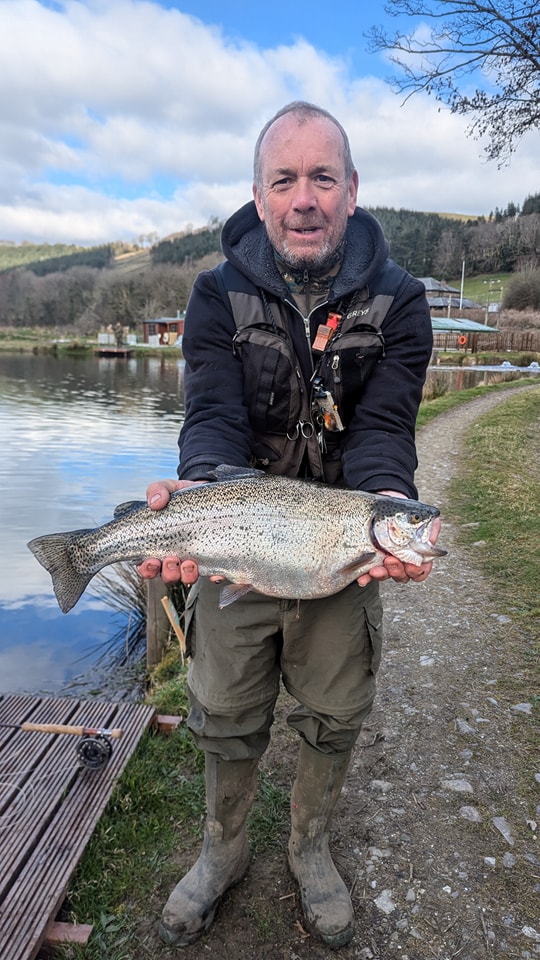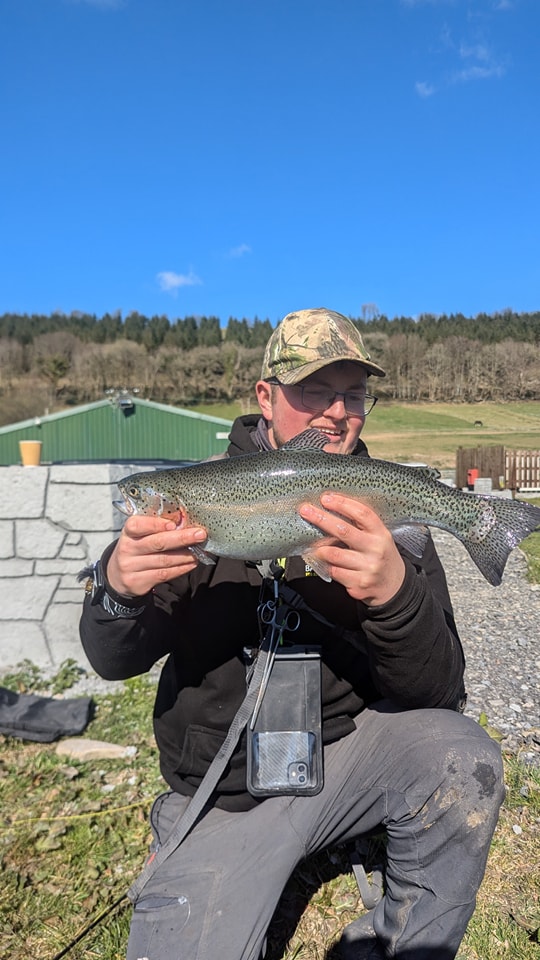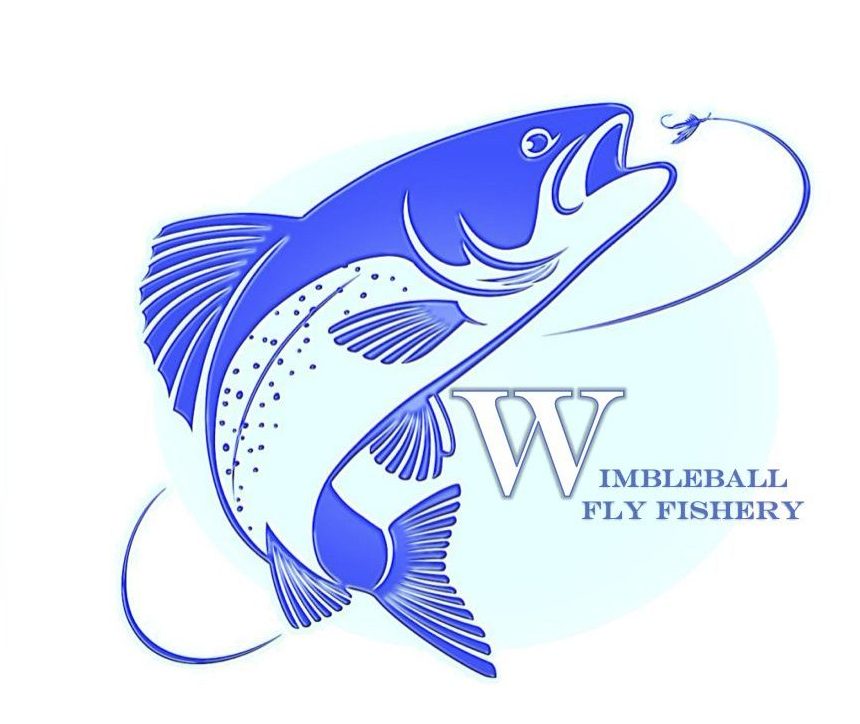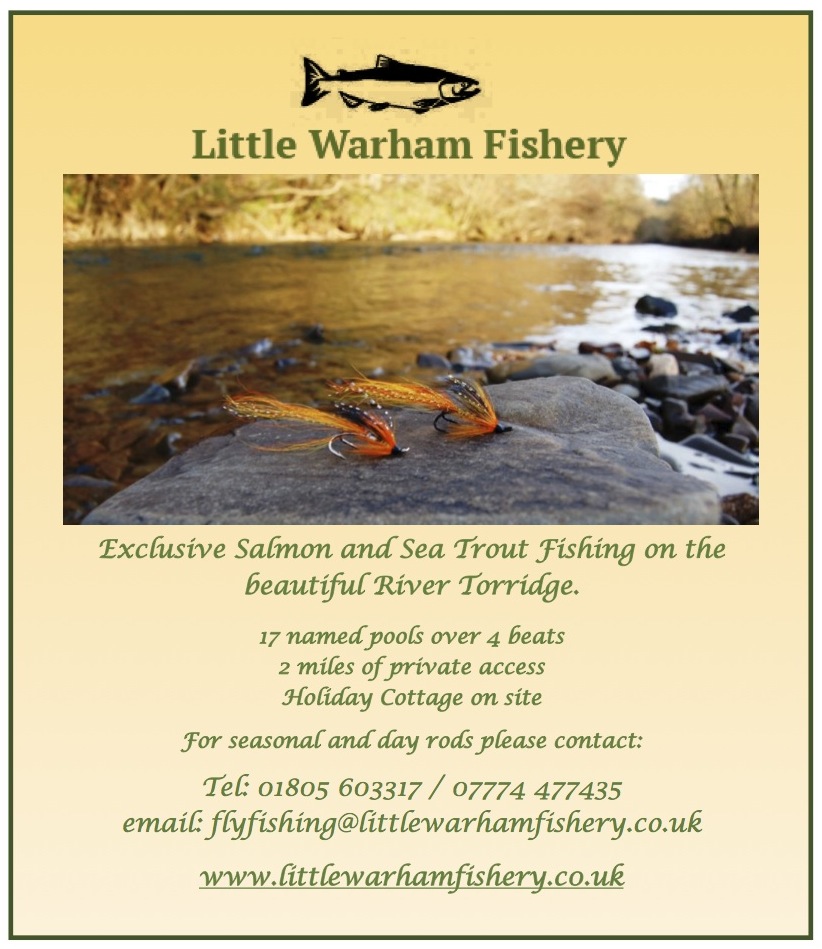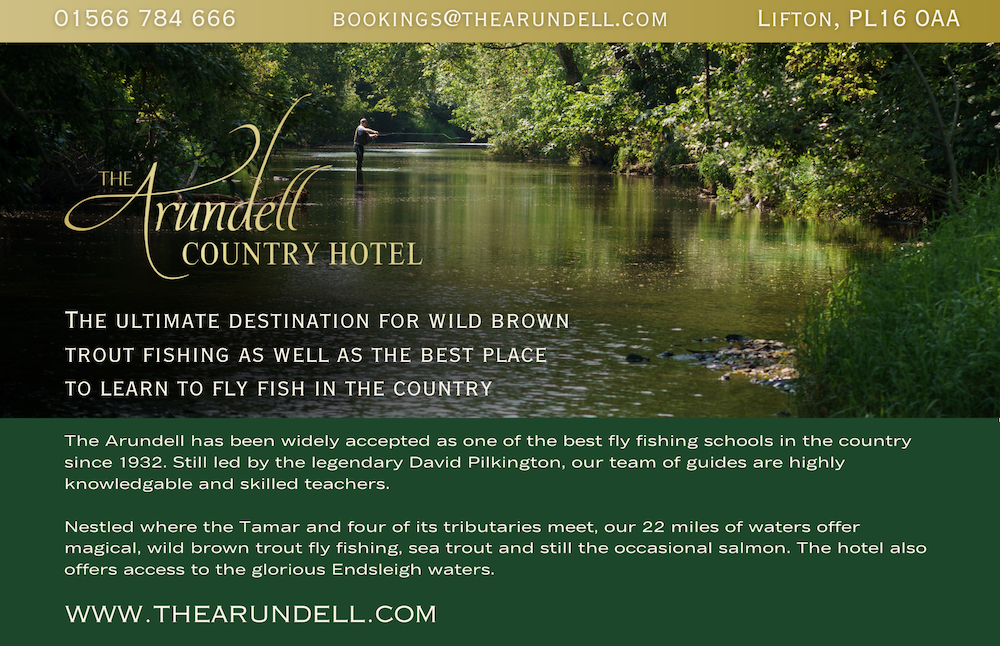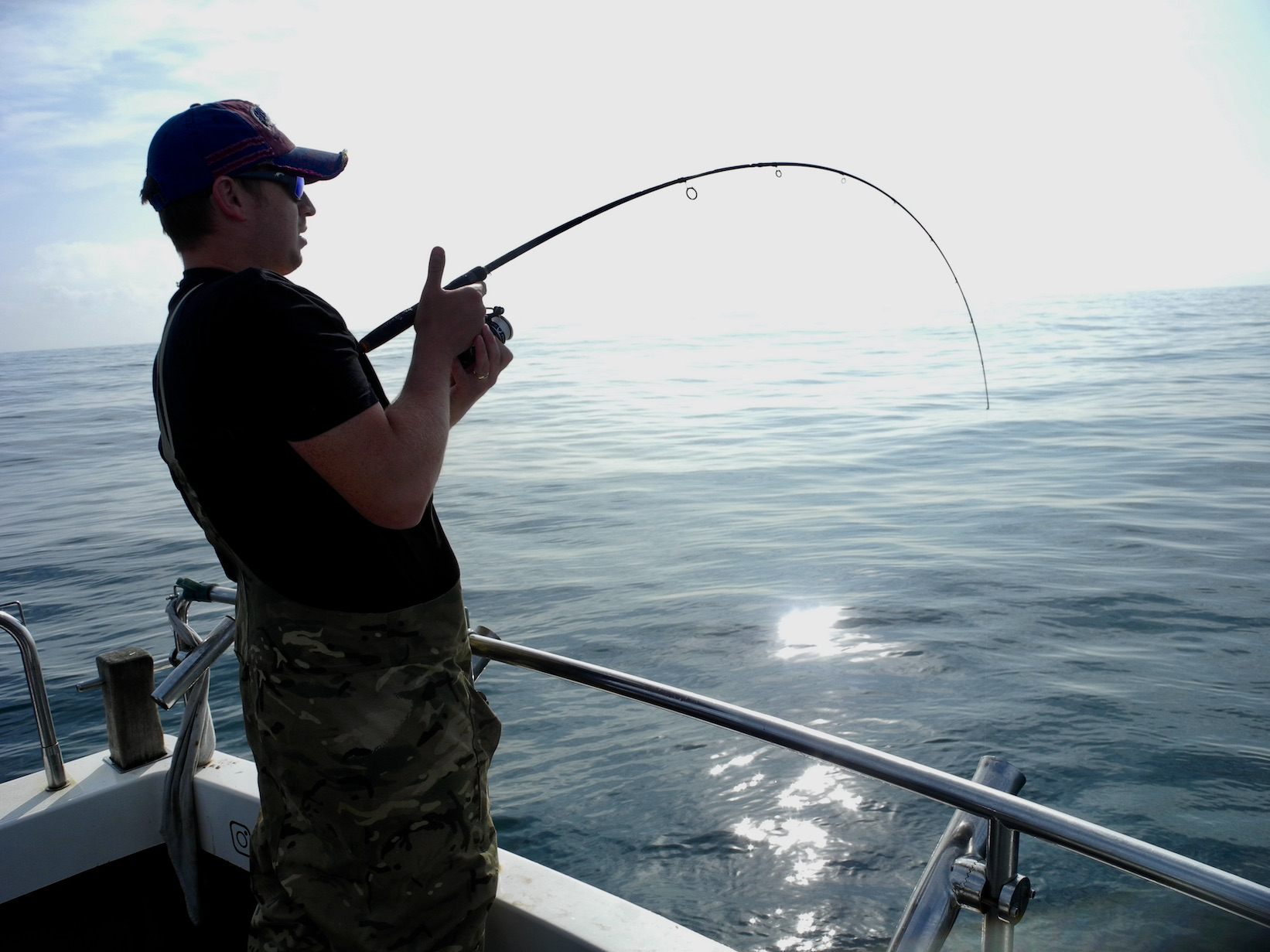
Slade Reservoir – First carp visit pays dividends.
Many thanks to Nick Woodger for allowing me use his write up on a first successful trip to Slade Reservoir.





Chasing Wimbleball Rainbows
Early April and to me this is trout season proper and where better to spend a day chasing rainbows than the fabulous Wimbleball nestled amongst Exmoor’s rural landscape.
I was fishing with my good friend Bruce Elston who had recently enjoyed catching his first double figure rainbow from Anglers Paradises Catch and release trout lake. We had originally intended to fish from the bank but recent catch reports indicated that the boats were starting to produce.
I was full of confidence despite the strong Easterly wind and bright sunshine. There was rain and cloud forecast for the afternoon so if the morning proved hard the afternoon would give a change of conditions.
We met at the boat pontoons for 8:30am after a pleasant drive as the morning sun rose to burn off any lingering morning mist. We were greeted by Mark Underhill who has worked so hard to make this fishery one of the best in the west country.
It was good to catch up and chat about prospects for the day and how well the fishery has been fishing recently. Judging by recent posts on social media the size of the rainbows this year are well worth chasing.
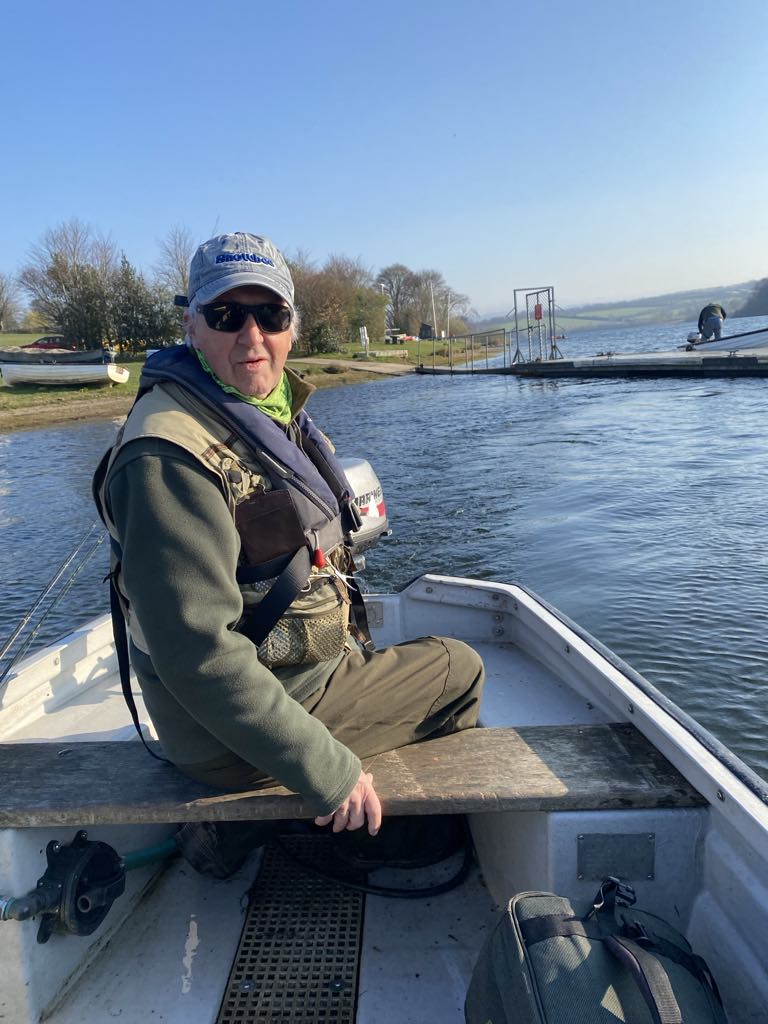
It was my turn as boat captain today and I suggested we start off with a drift or two in Cowmoor Bay that would offer a degree of shelter from the strong wind. We headed up into the wide bay towards the far end and commenced drifting using a drogue to slow the pace. I hooked a rainbow on the second drift that came adrift but this at least gave that much needed confidence boost.
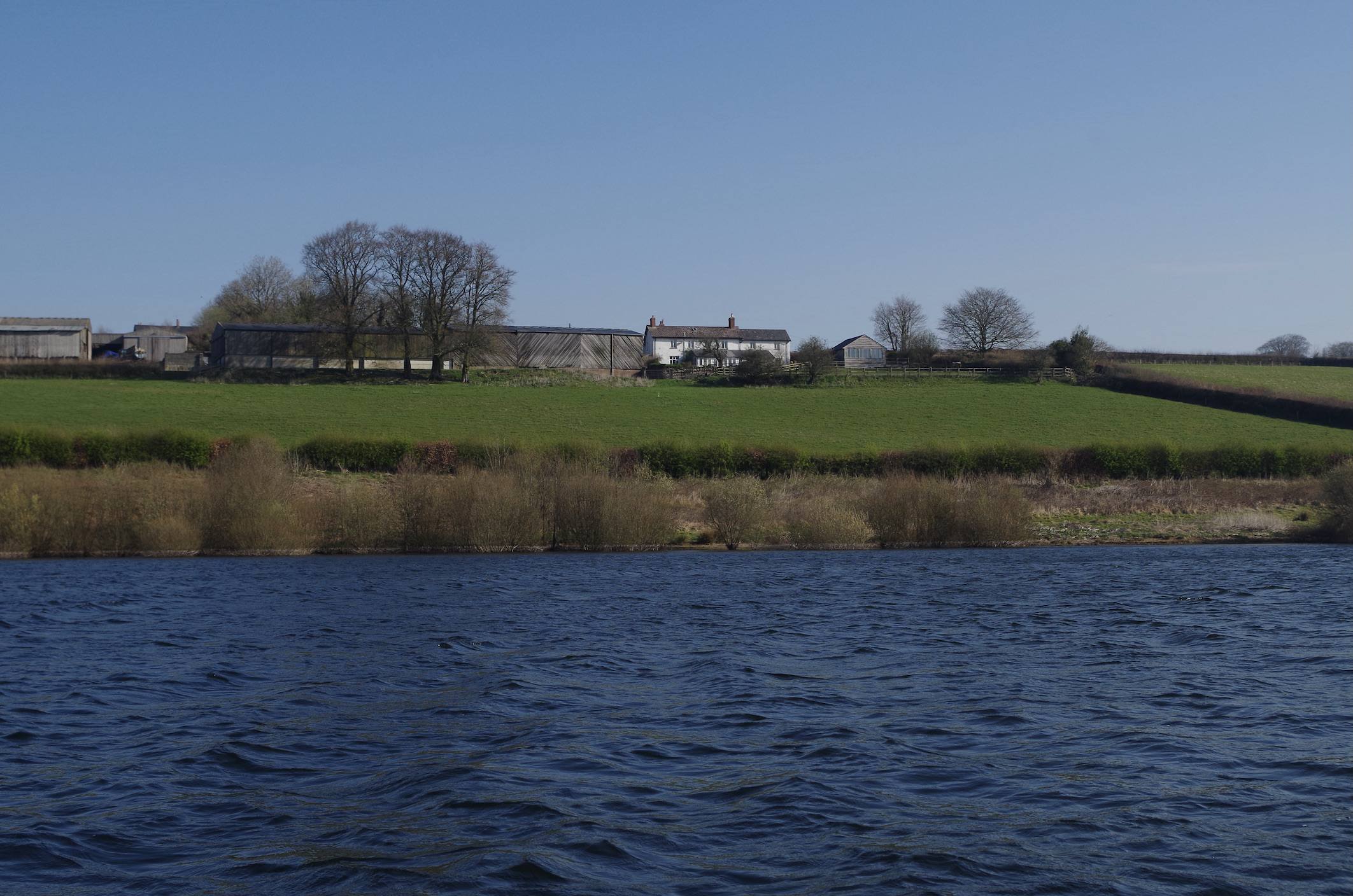
It was good to spot the first martins of the spring swooping over the water after their long migration from the African continent. The sighting of the spring migrants always boosts my spirits knowing that natures cycle is still turning as it should.
It soon became apparent that even with a drogue the drift was a bit too brisk and I suggested we head up to the dam end. We tied up to the rope that marks the dam area and spent half an hour searching the deep water to no avail.
I was using a fast sink Snowbee line with an olive damsel on the point and a bright orange blob on the dropper. Bruce was using a single black damsel.
The calmer waters of the Upton Arm beckoned we motored up into the wooded bay that always inspires. Wooded banks with branches trailing into deep clear water. Buzzards gliding high above and birdsong drifting in the spring air.
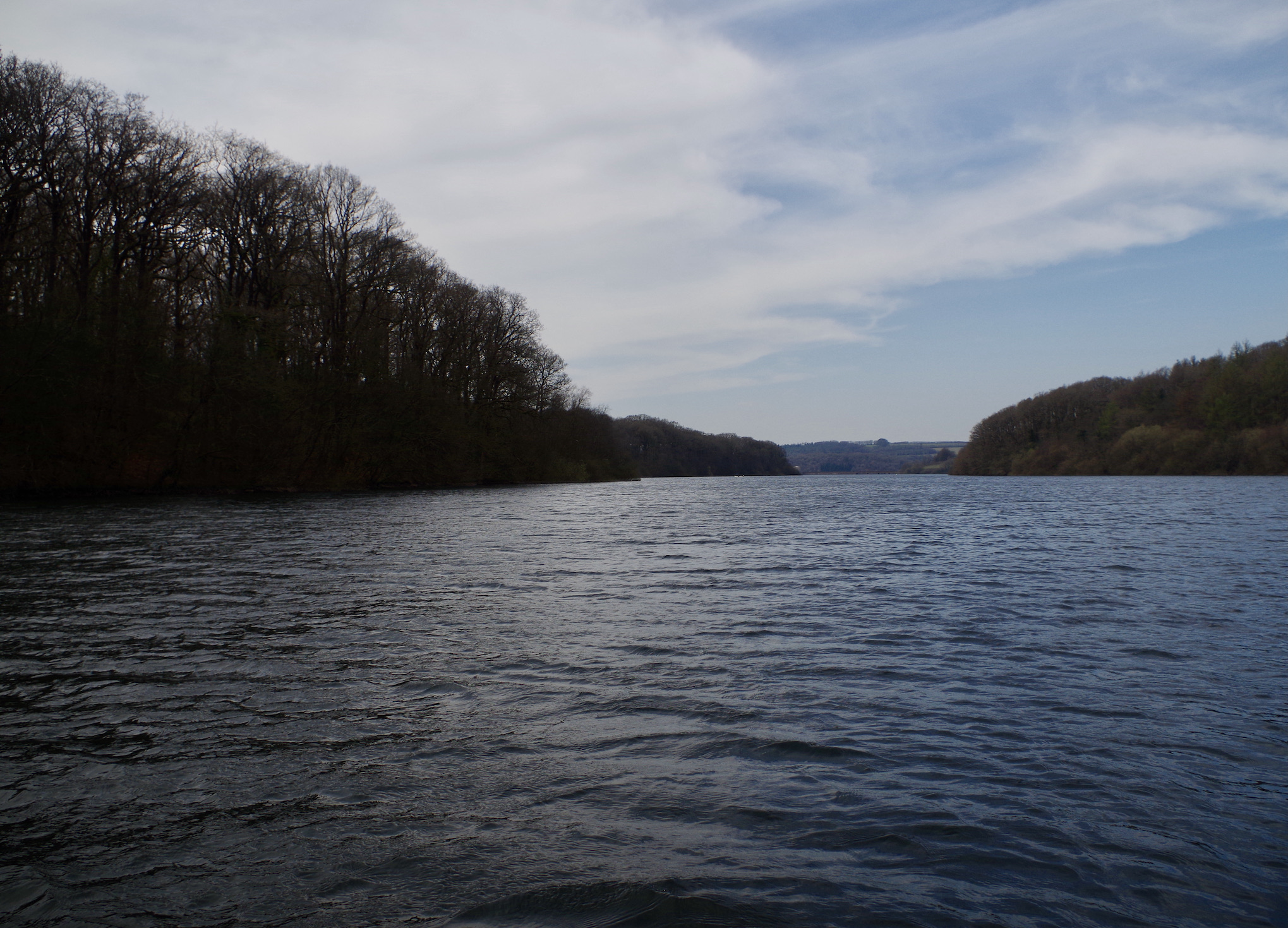
Action soon came our way as we drifted close to the bank with the trout seemingly close to the edge patrolling the steep drop off contours. We caught fish pretty well every drift throughout late morning. All hard fighting fish averaging between 2lb and 3lb.
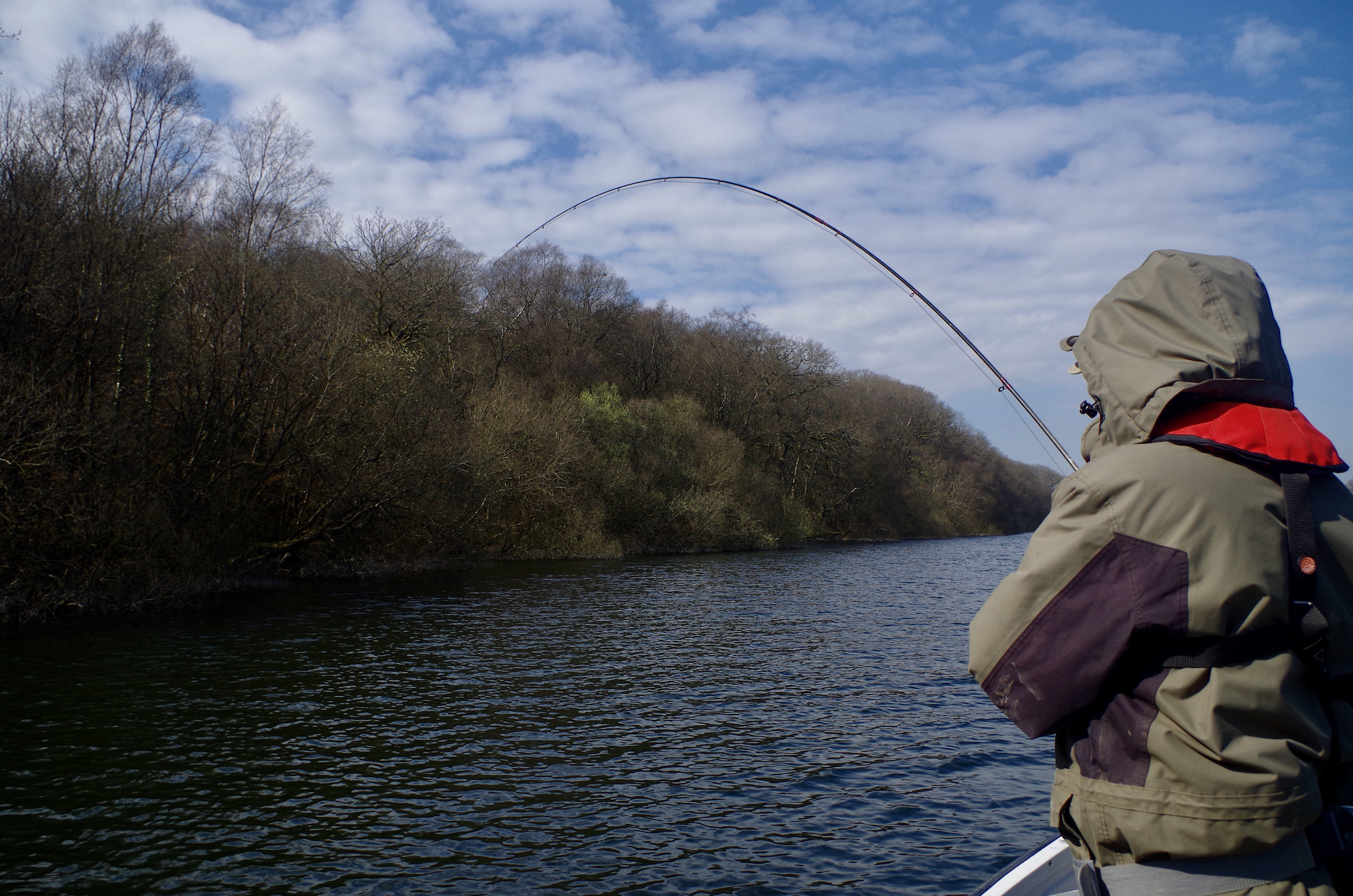
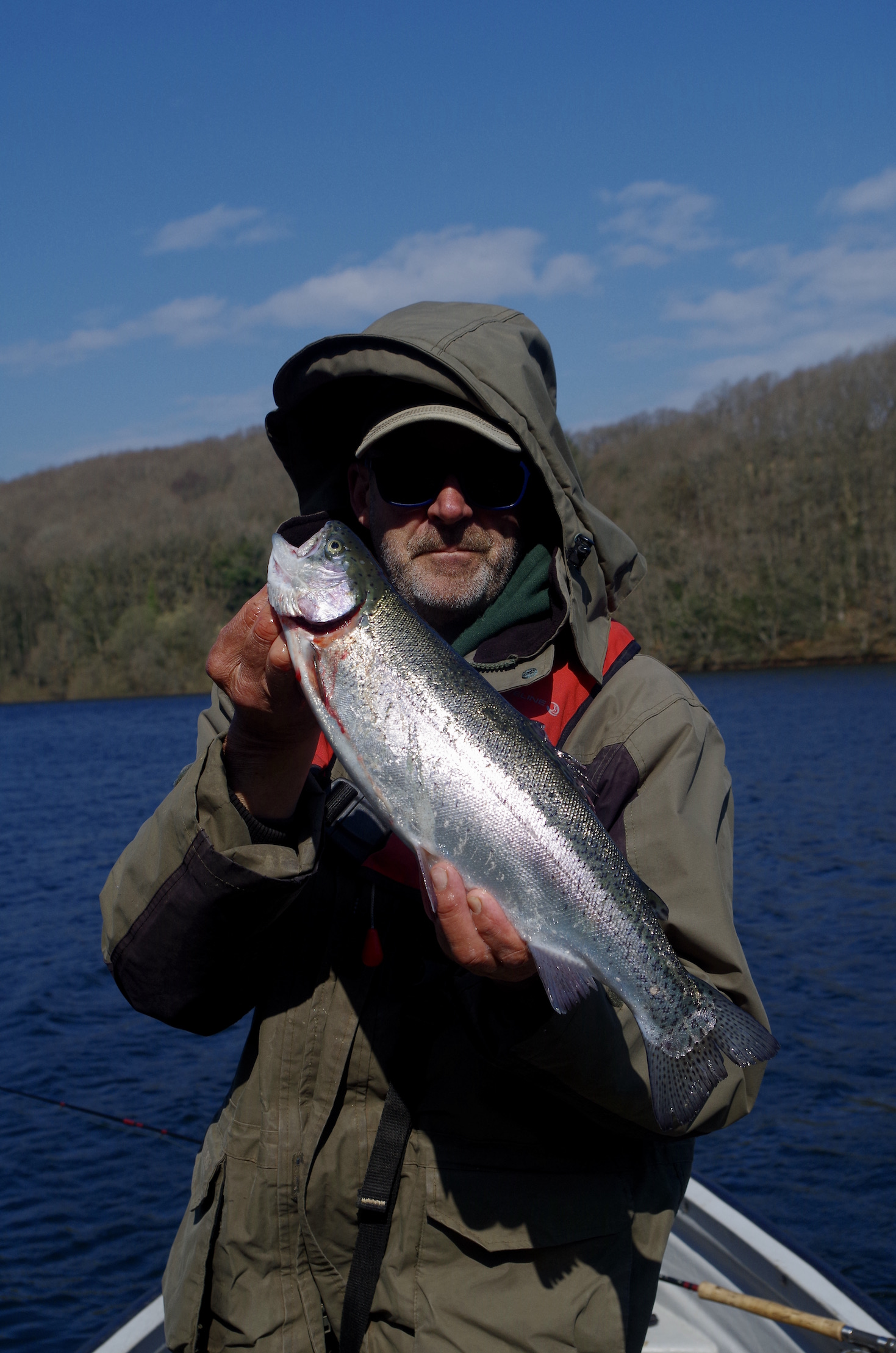
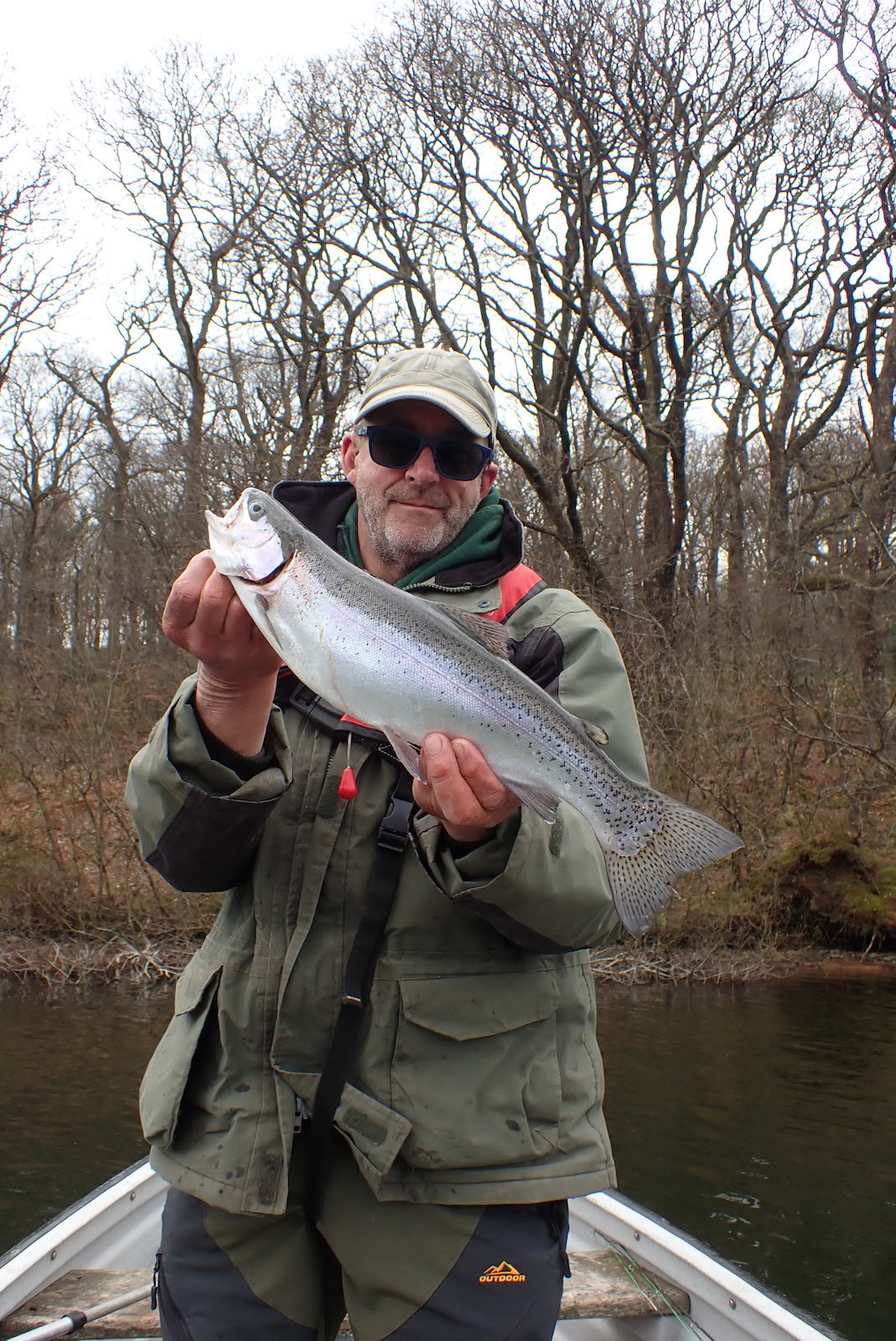
When our catch rate eased we decided to try the opposite bank where the wind was blowing harder. First cast I noted a swirl behind my fly as a trout lunged at the fly. The wind was pushing us rapidly into the bank and as I lifted the rod a huge rainbow appeared behind the lure turning away as I ran out of water. Bruce and I both gasped in awe at its size. One of those would certainly make our day!
With the wind making it very difficult we decided to take a break and return to the calmer bay we had been fishing and take a bit of lunch with the anchor lowered. I grabbed a sandwich and an iced coffee between casts. Bruce set up a nymphing set up with a sight indicator and allowed the set up to drift gently just off the overhanging tree line.

Bruce missed a couple of takes but it was third time lucky when he tightened into a fish that took off with a stunning turn of speed. Bruce hung on and relished the pulsing rod as line was ripped from the reel on a couple of long runs out into the bay. Eventually the fish settled into a closer range tussle a couple of rod lengths from the boat. Each time Bruce encouraged the fish close to the net it would surge off again. It was obviously a good fish that we estimated at around 7lb. It wasn’t until it slid over the rim of the net that we got an idea of its true size. A deep flanked fish in perfect condition with wide and powerful tail. Bruce decided to keep the fish and we were both stunned when the scales told a weight of 9lb 14oz!
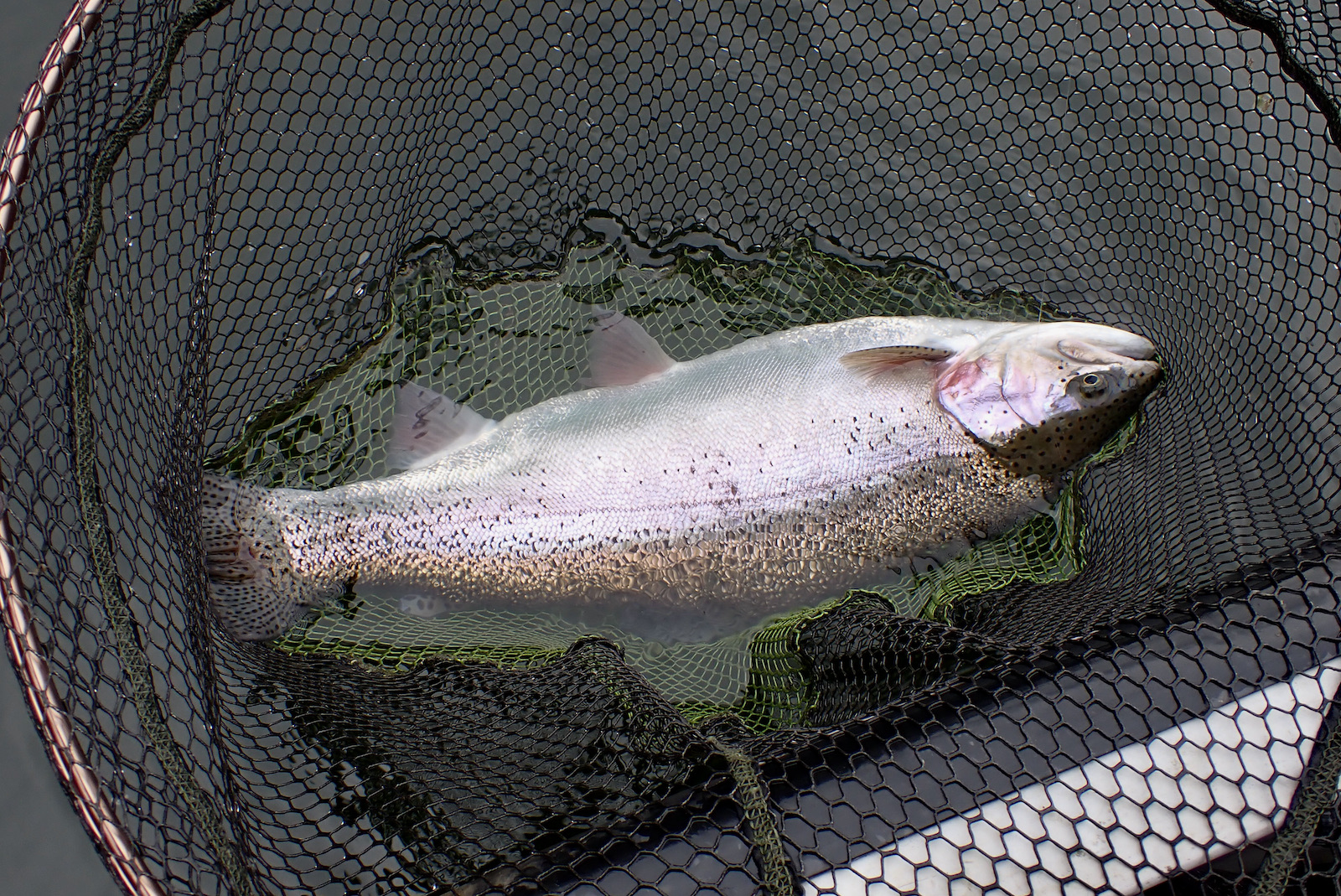
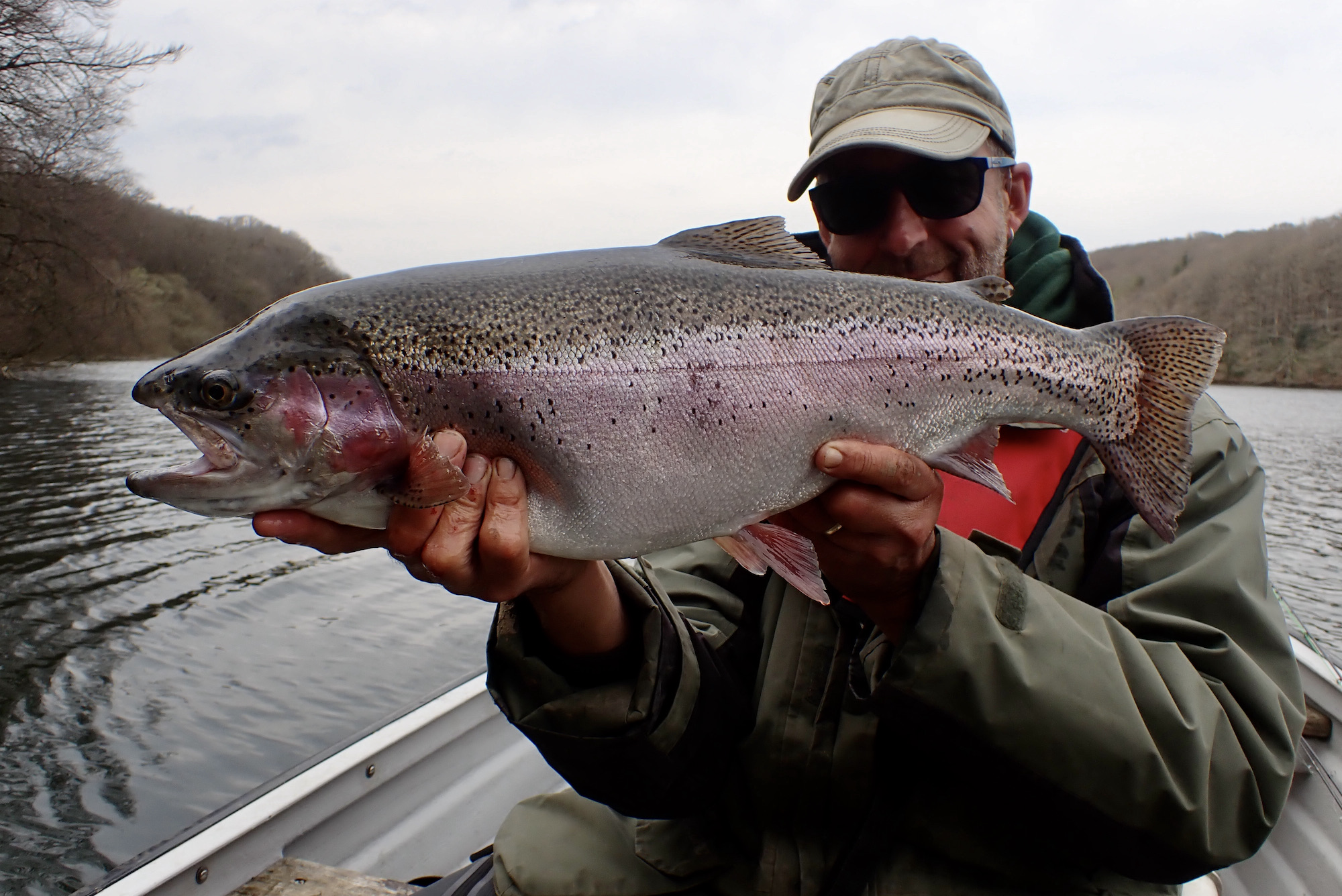
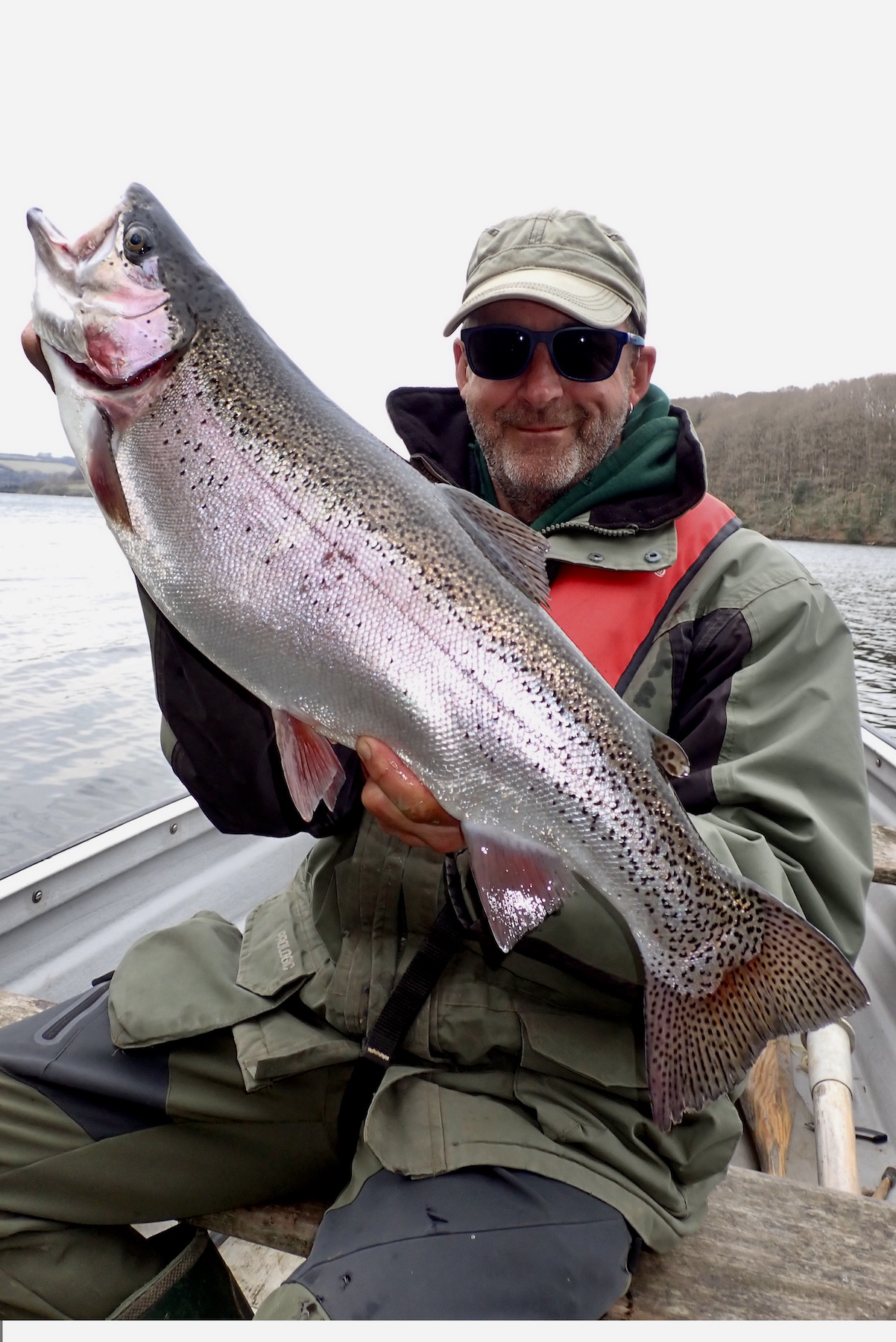
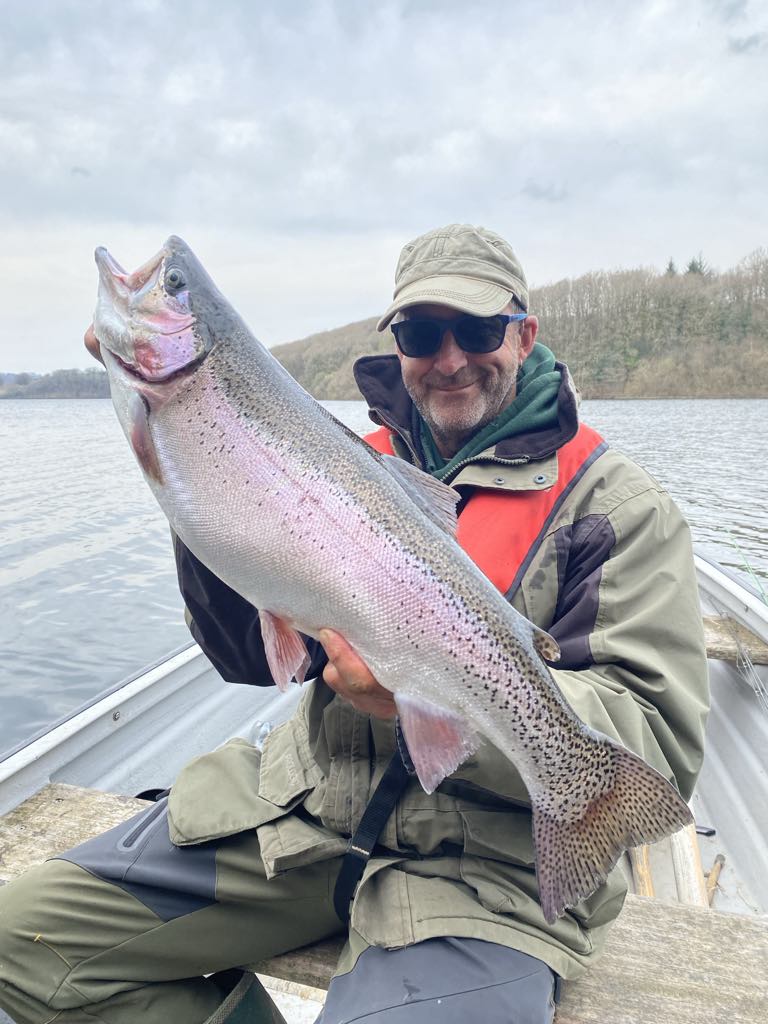
What was most thought provoking was that the fish we had seen earlier appeared much bigger than this one. We caught a few more in the bay and then embarked upon a search back on the far side where we had seen the big fish.
We found that if we positioned the boat carefully thirty yards or so off the bank we could drift into the shoreline where the trout were lurking then start the motor and push back out to drift back in; zig zagging along the bank like this we searched the margin adding trout or missing takes most drifts. I also glimpsed another monster of a rainbow that missed my damsel by an inch as we ran out of water at the end of a drift.
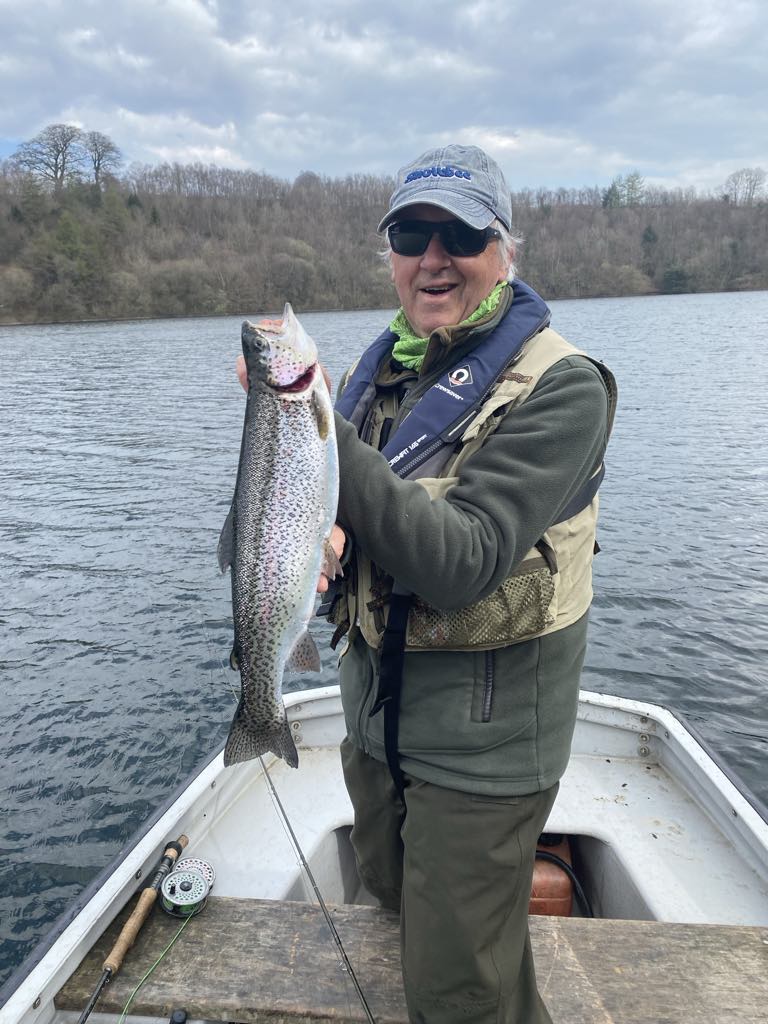

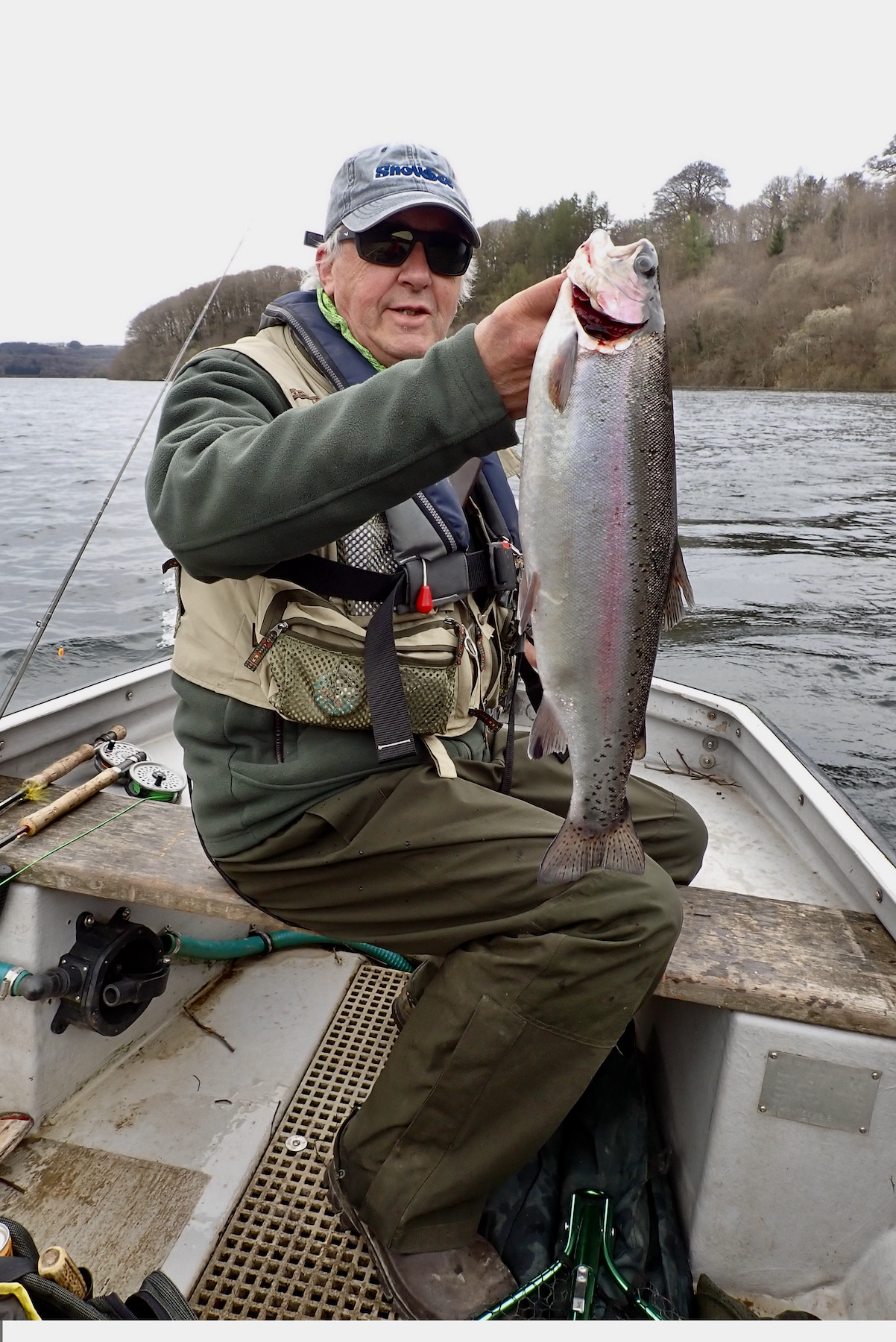
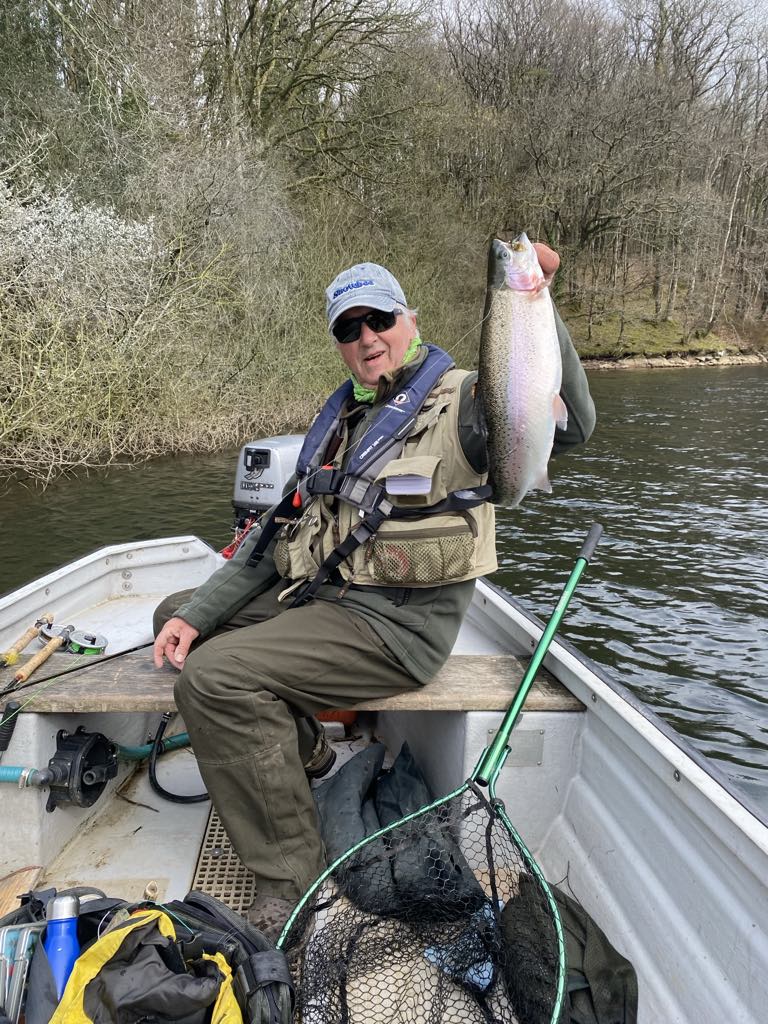
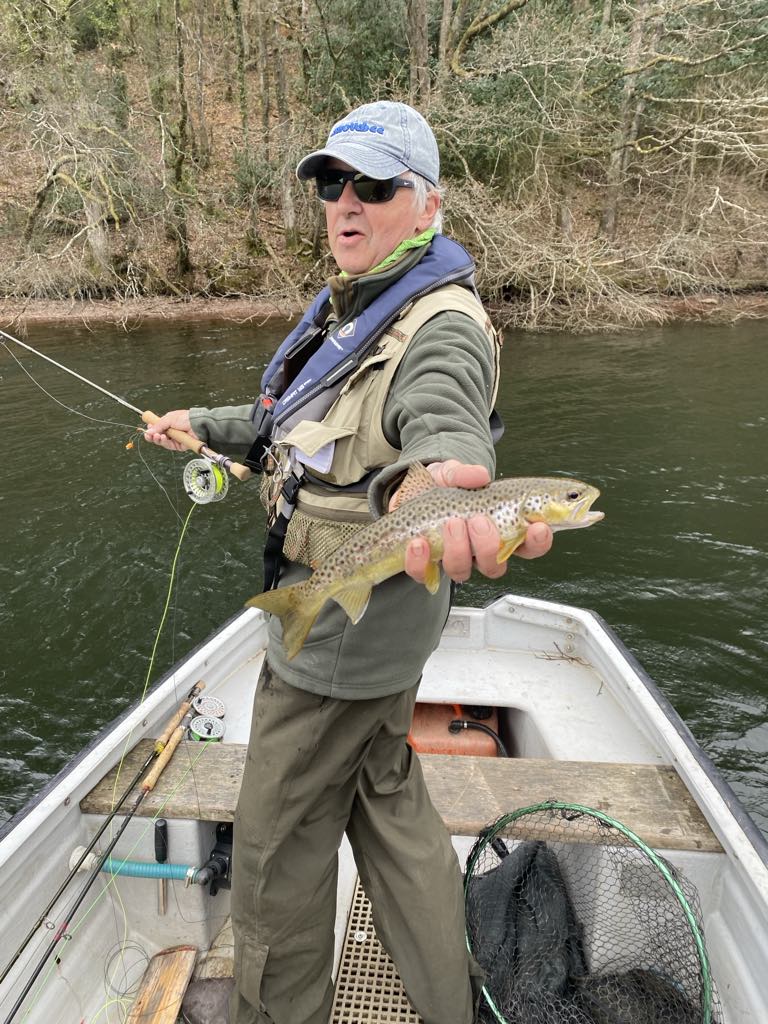
Sport eased for the last hour as rain started to fall. Bruce commented that it had been his best days trout fishing ever and he relished the exciting tug of the trout smashing into the lure. We headed back to the pontoon arms aching slightly, reflecting upon another day of memories made. We ended the day on seven trout each averaging close to 3lb with one solitary wild brown trout. The coming months should bring plenty of great days on this wonderfully wild water. Its stunning rainbows testament to an ambitious stocking program.
In addition to the stocked rainbows there are also some stunning wild brown trout that undoubtedly exceed 10lb! Now that really would be the fish of dreams….
Stocking hope – Torridge Hatchery
The Hatchery Project: has been a great success this year with about 33,000 swim-up fry stocked out in selected sites in the headwaters during late March. The association were able to trap their broodstock from the fish pass at Monkokehampton Weir with relative ease at the end of November and by mid-December all five hens had been stripped and the eggs fertilised. The alevin started to hatch at the end of January and have grown on steadily with very limited mortality. The weather has helped: it has been a colder winter than average with the water temperature only once going above 10C.
Many thanks to Alex Rowson who kindly sent the images below showing the transfer of swim up fry from Torridge Hatchery to a tributary of the River Torridge.
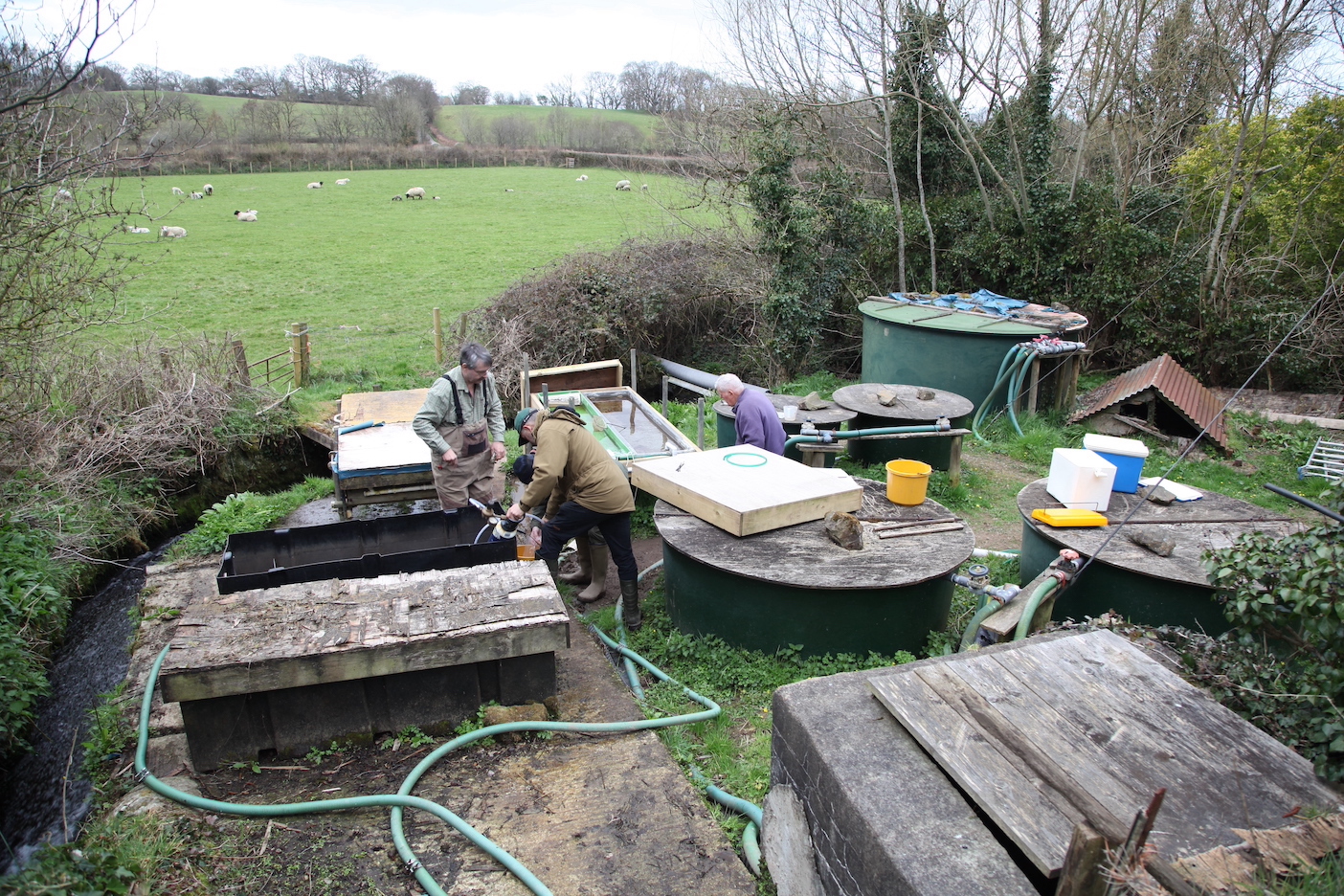
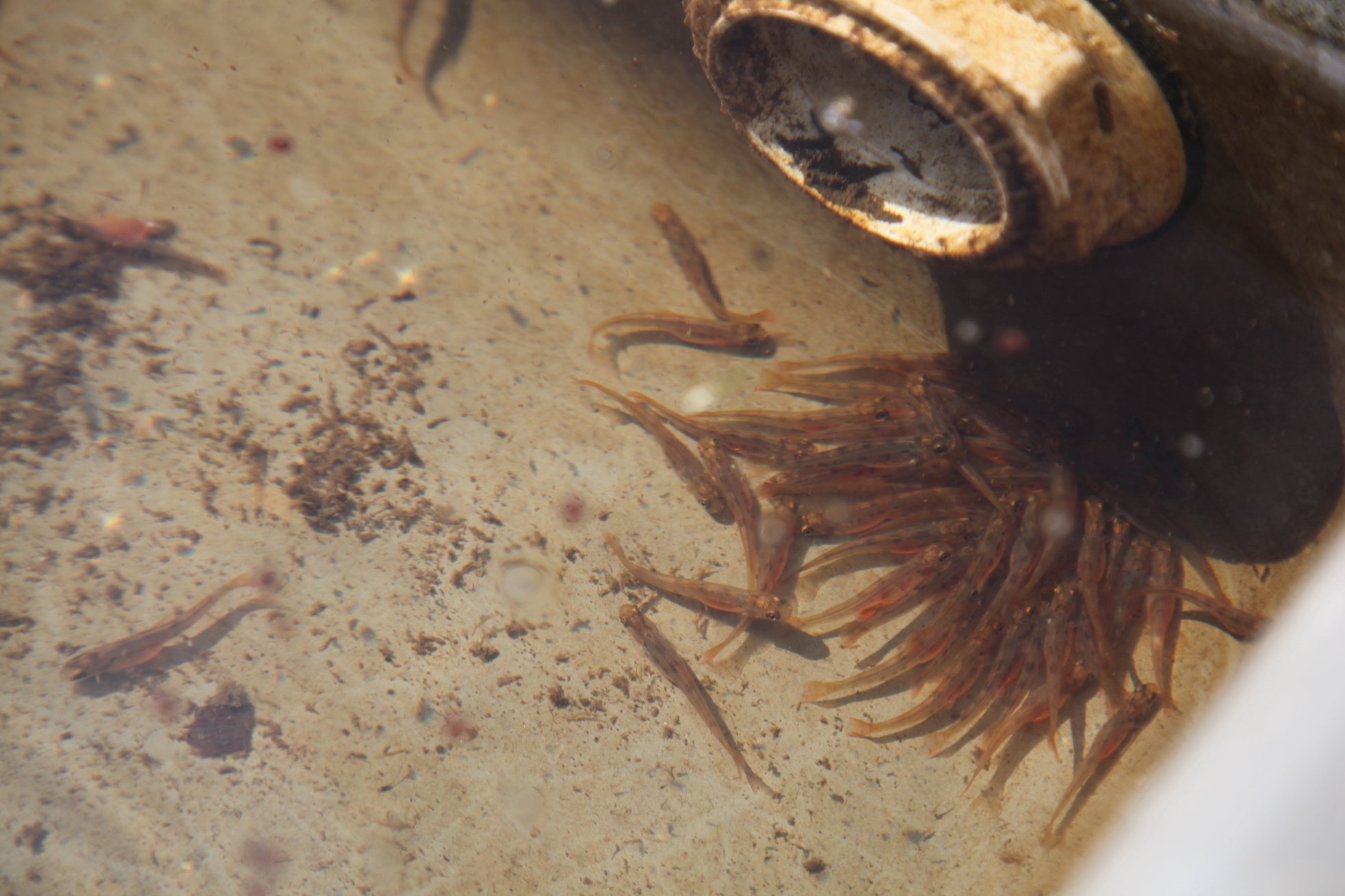
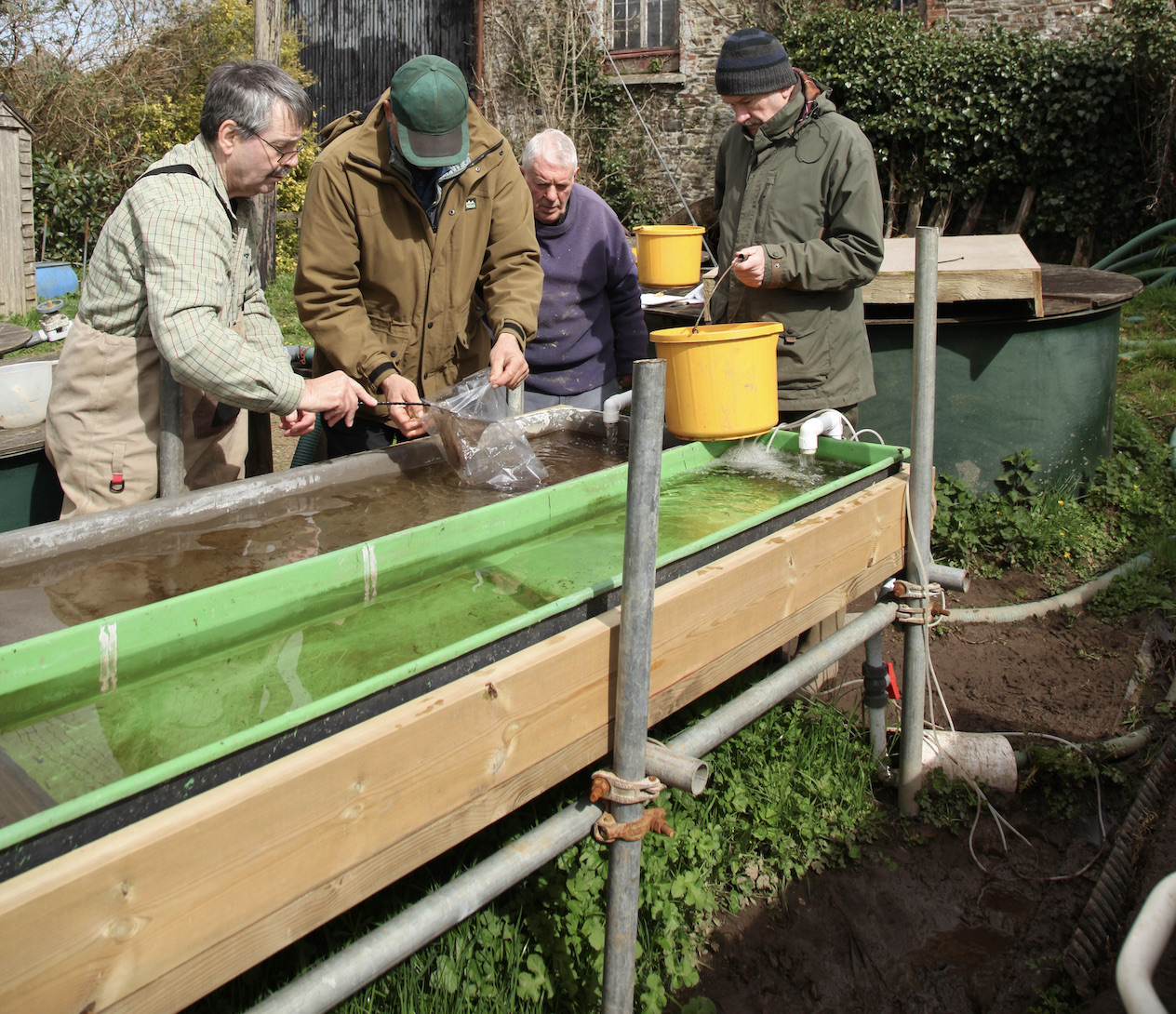
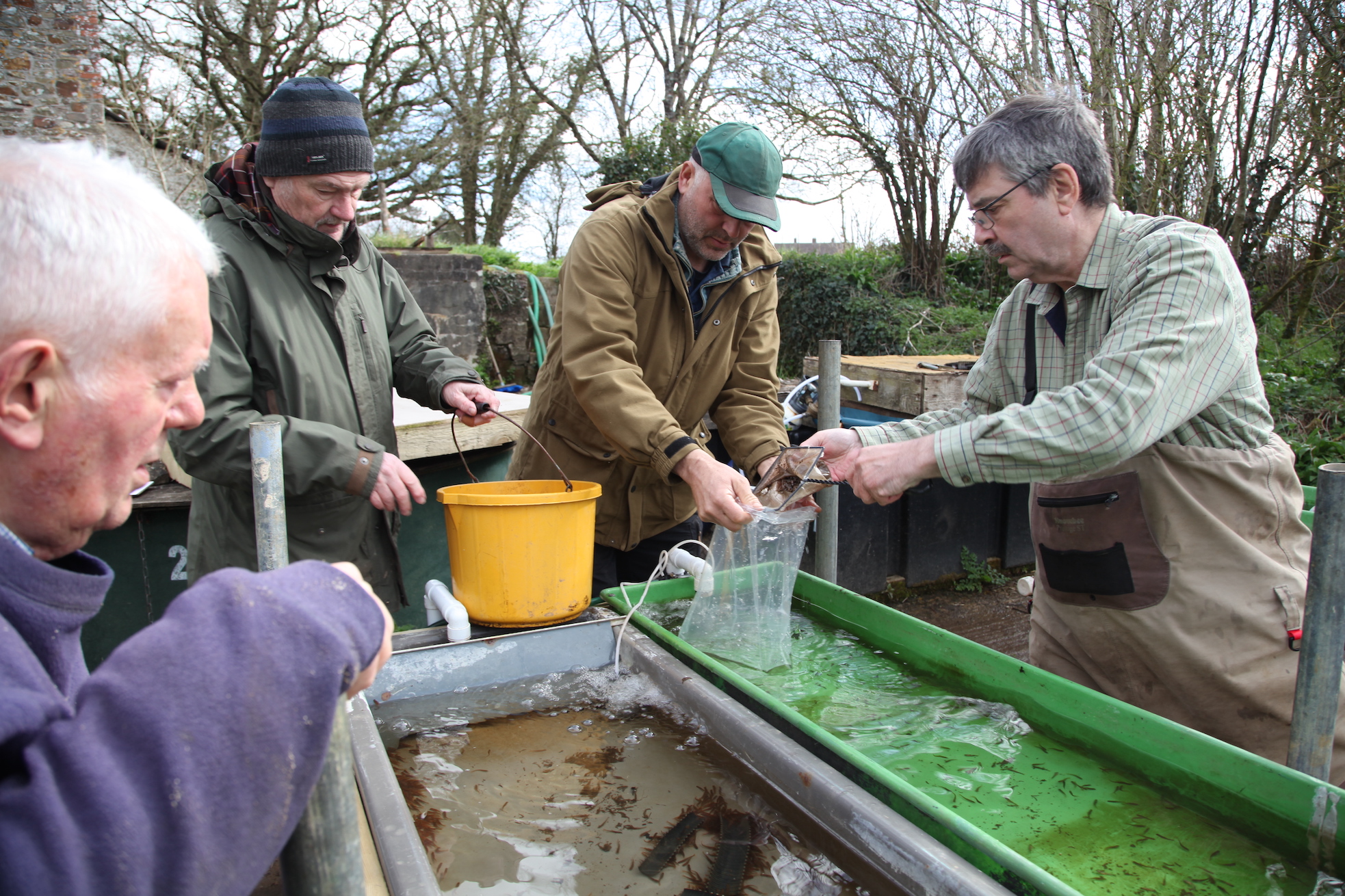
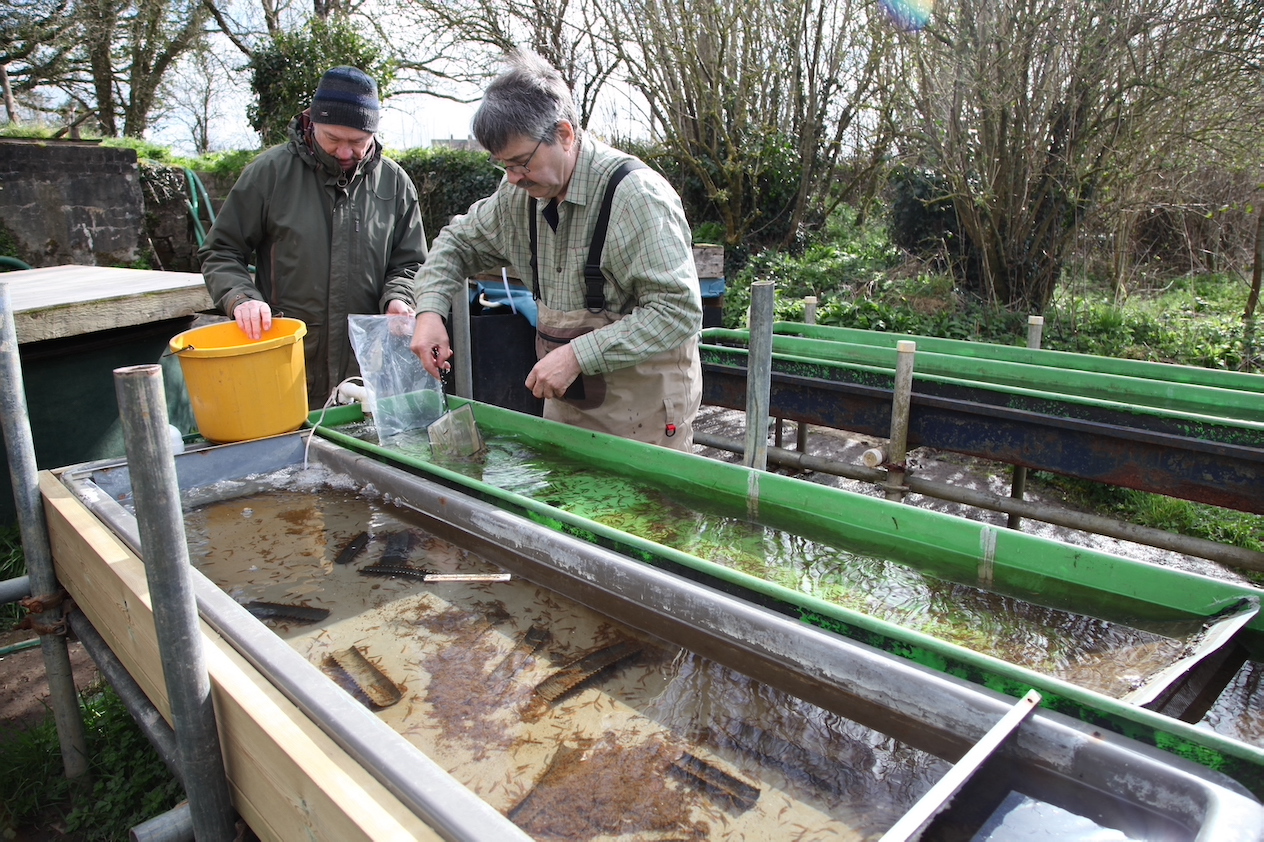
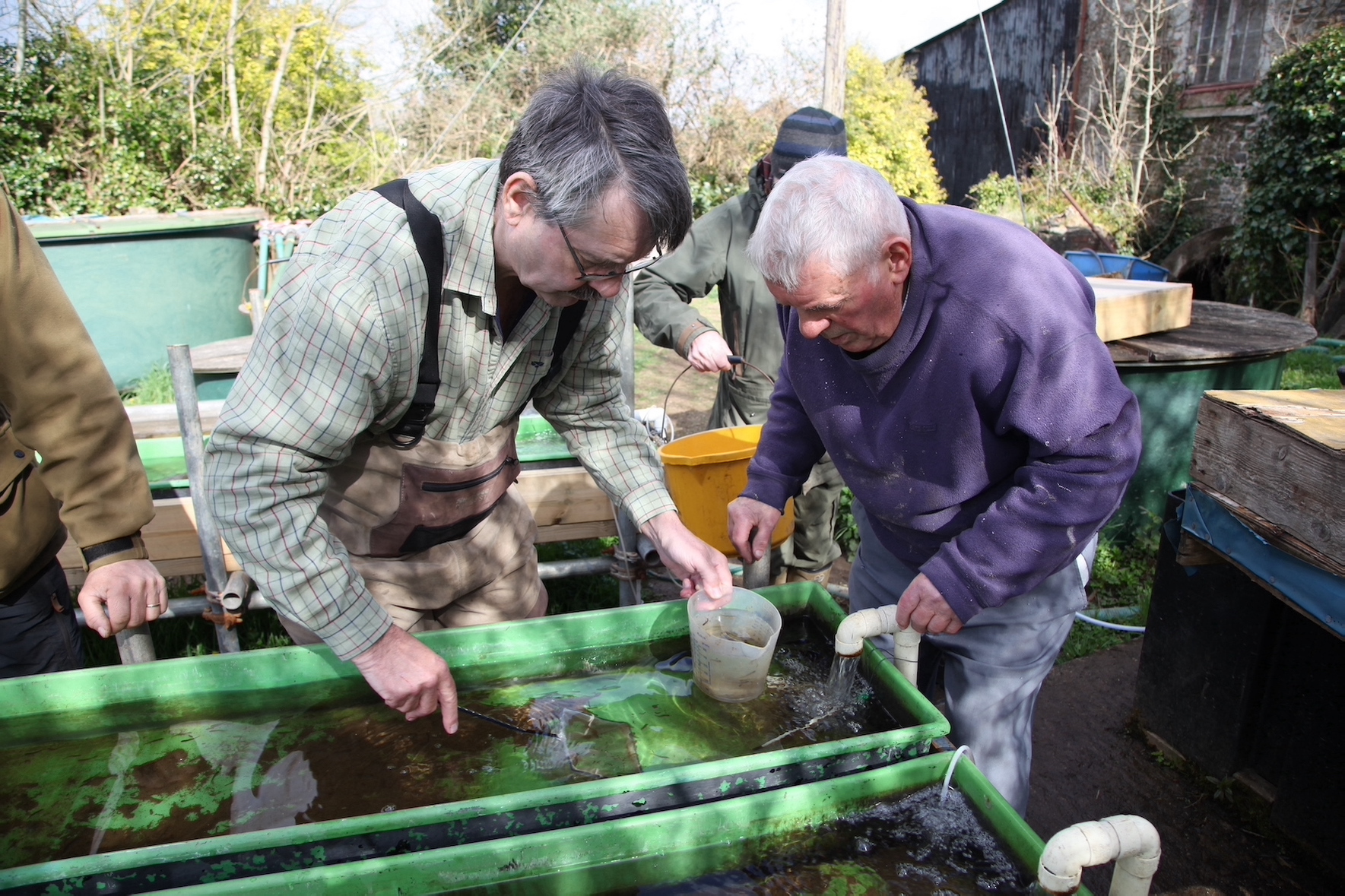
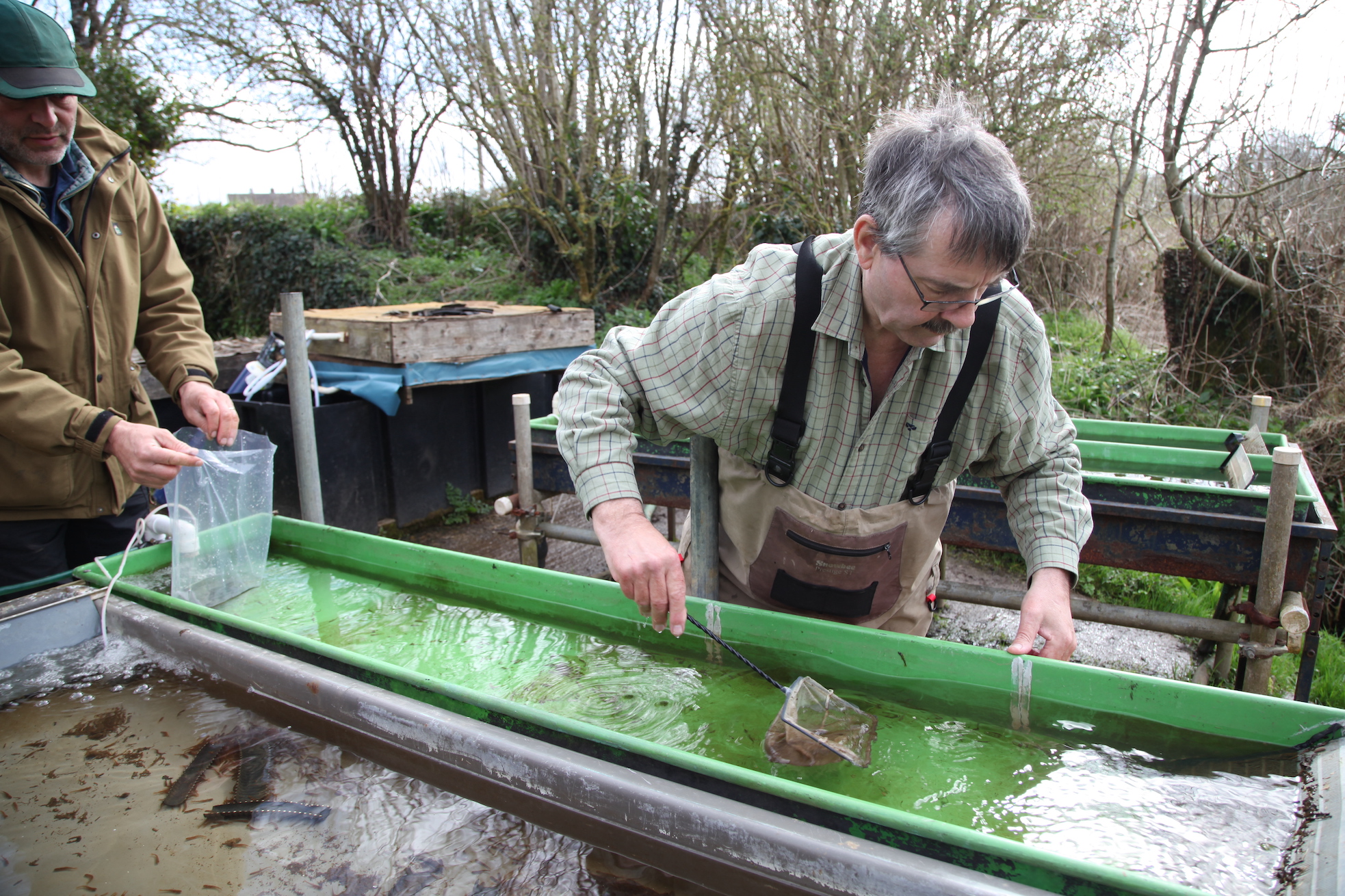
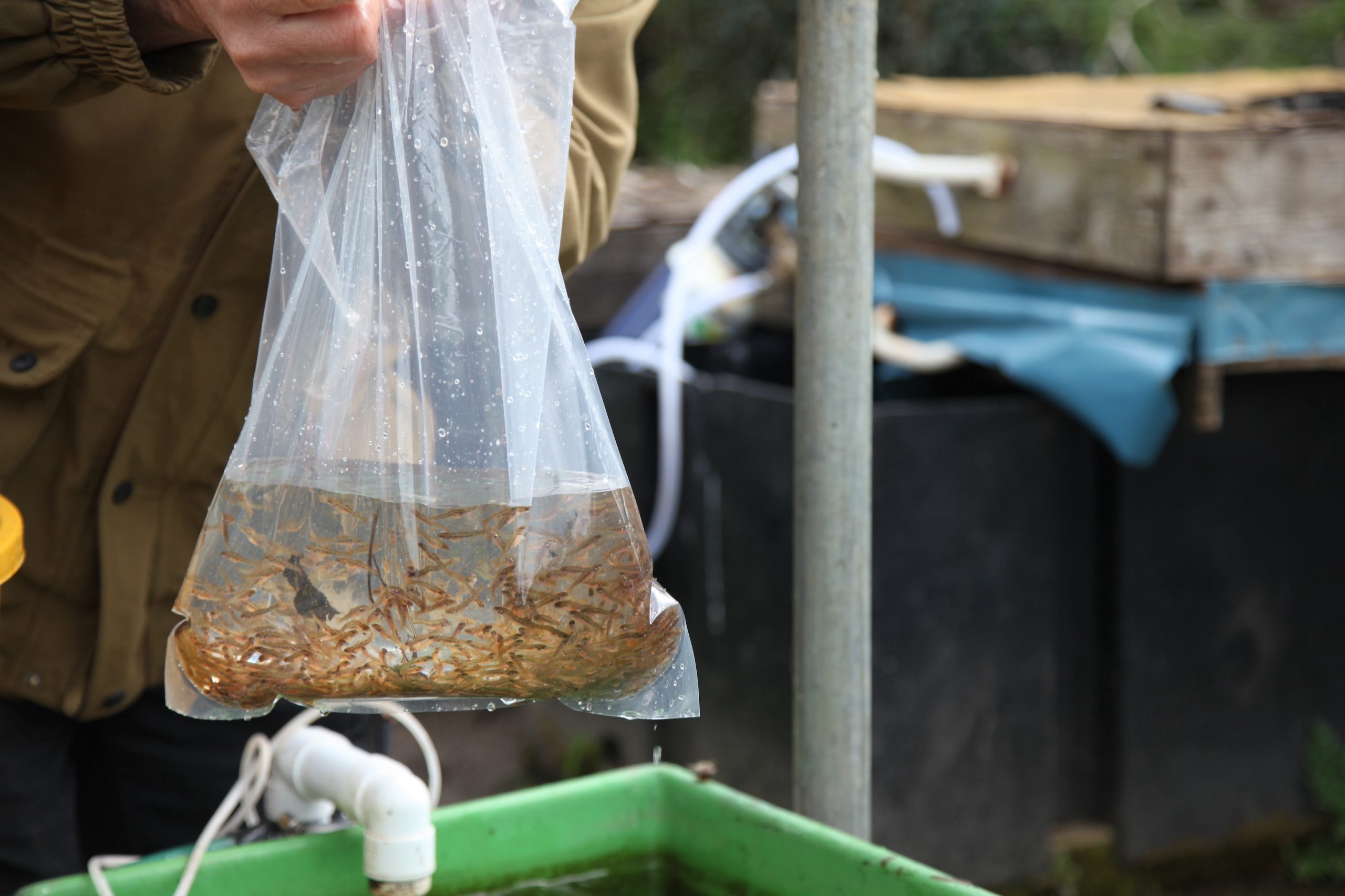
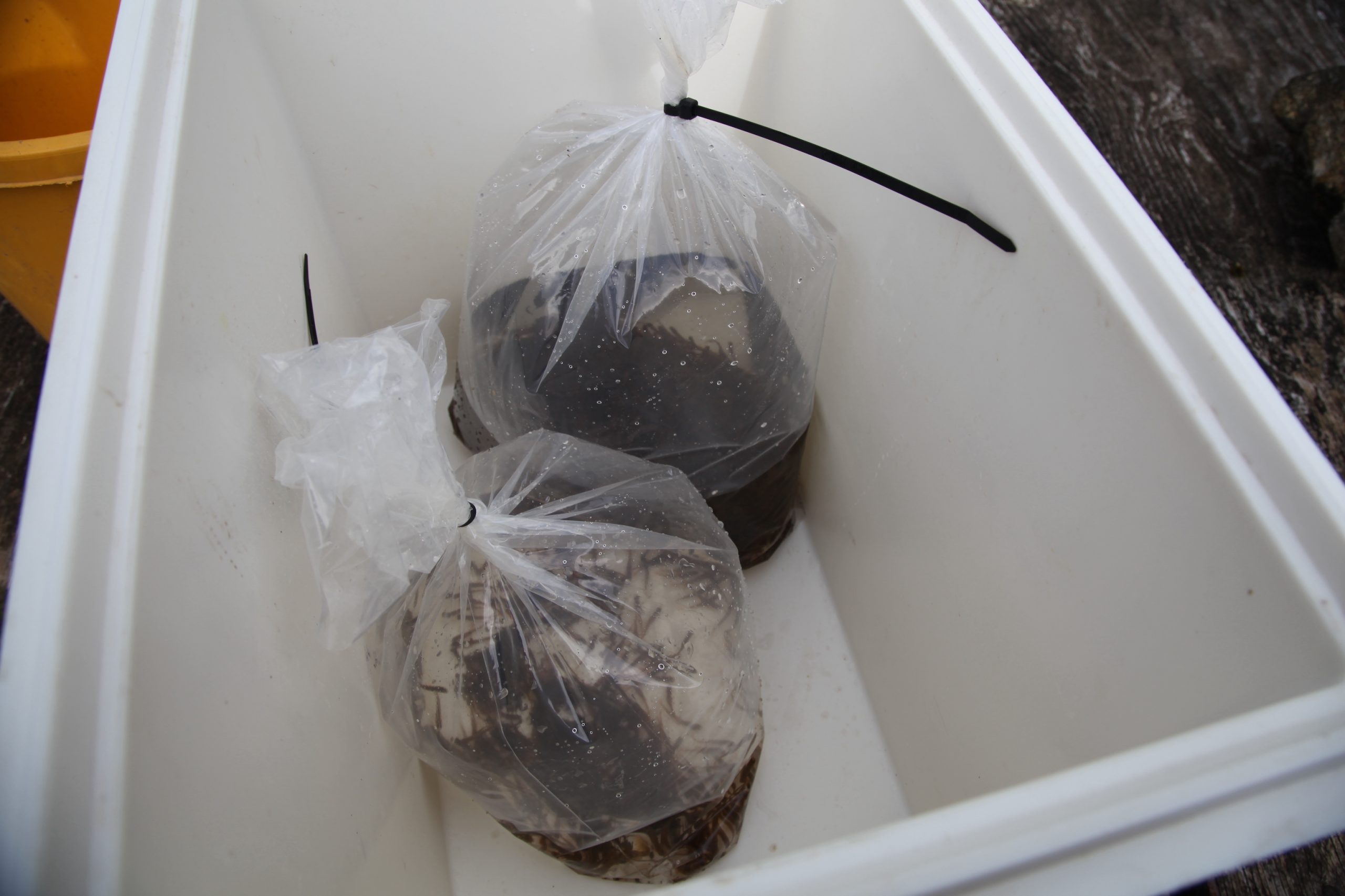
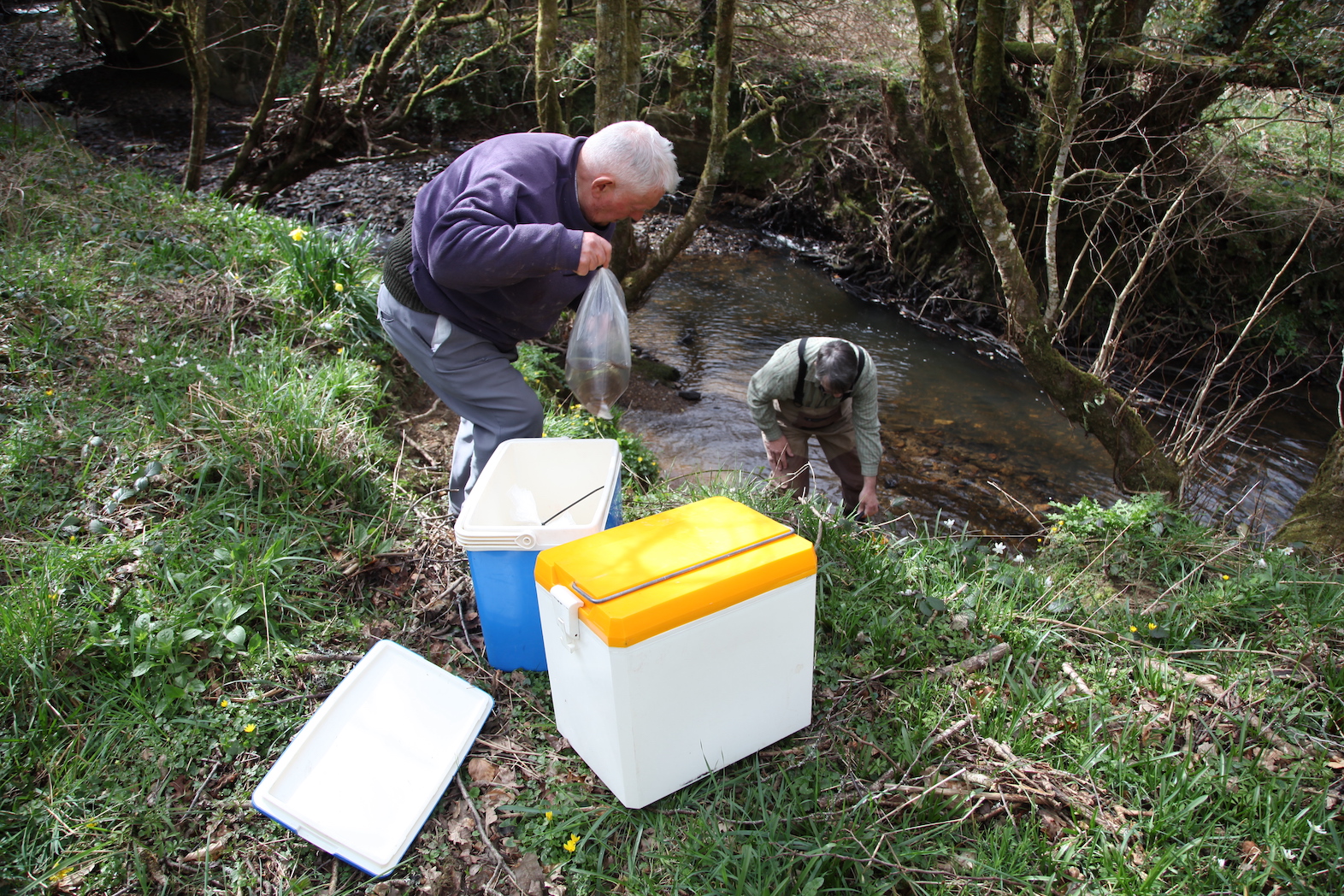
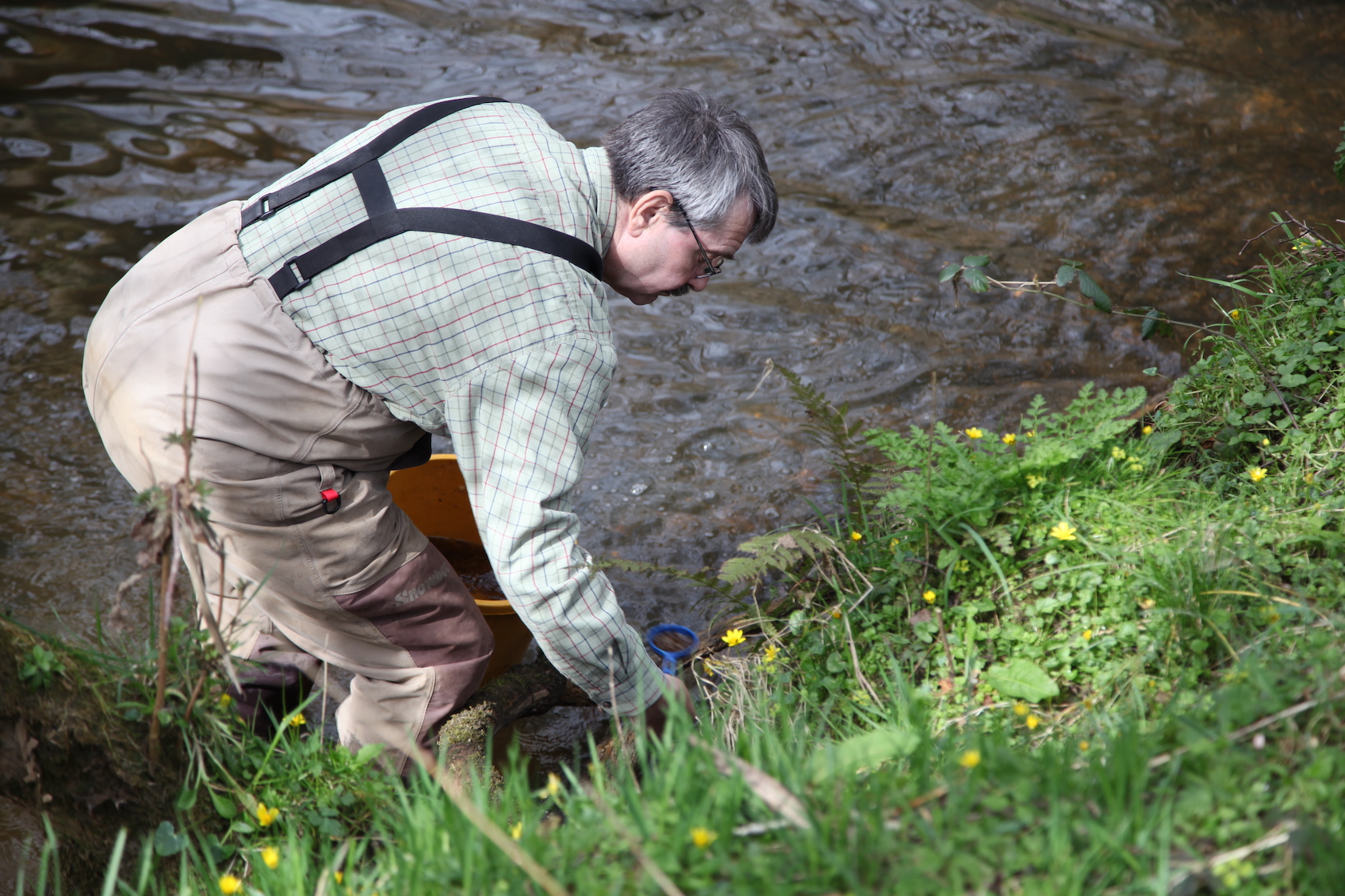
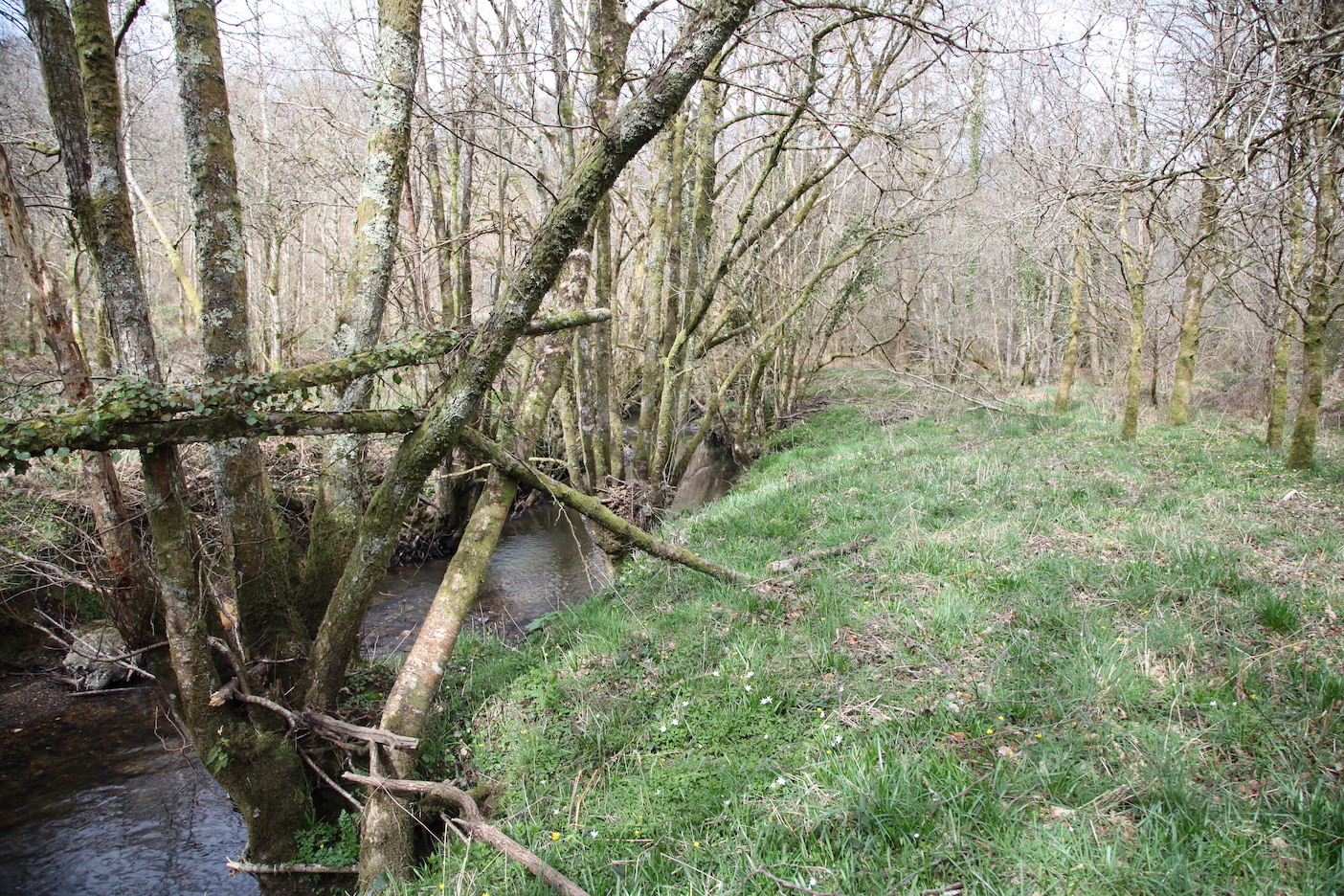
Looking back through my many images I discovered to my amazement that the hatchery has now been running since at least 2008. It is still very difficult to assess its success but it has given hope to Torridge River Association and as each salmon is so valuable it is likely that it has helped the river cling on to its dwindling salmon population. The project works in line with other efforts to protect and enhance the complex river environment.
Since posting this I have spoken with Paul Carter who informed me that next years is the hatcheries 20th season and an average of 30,000 swim up fry have been into the Torridge system a total of 600000. This has surely helped the salmon maintain a foothold in the river.
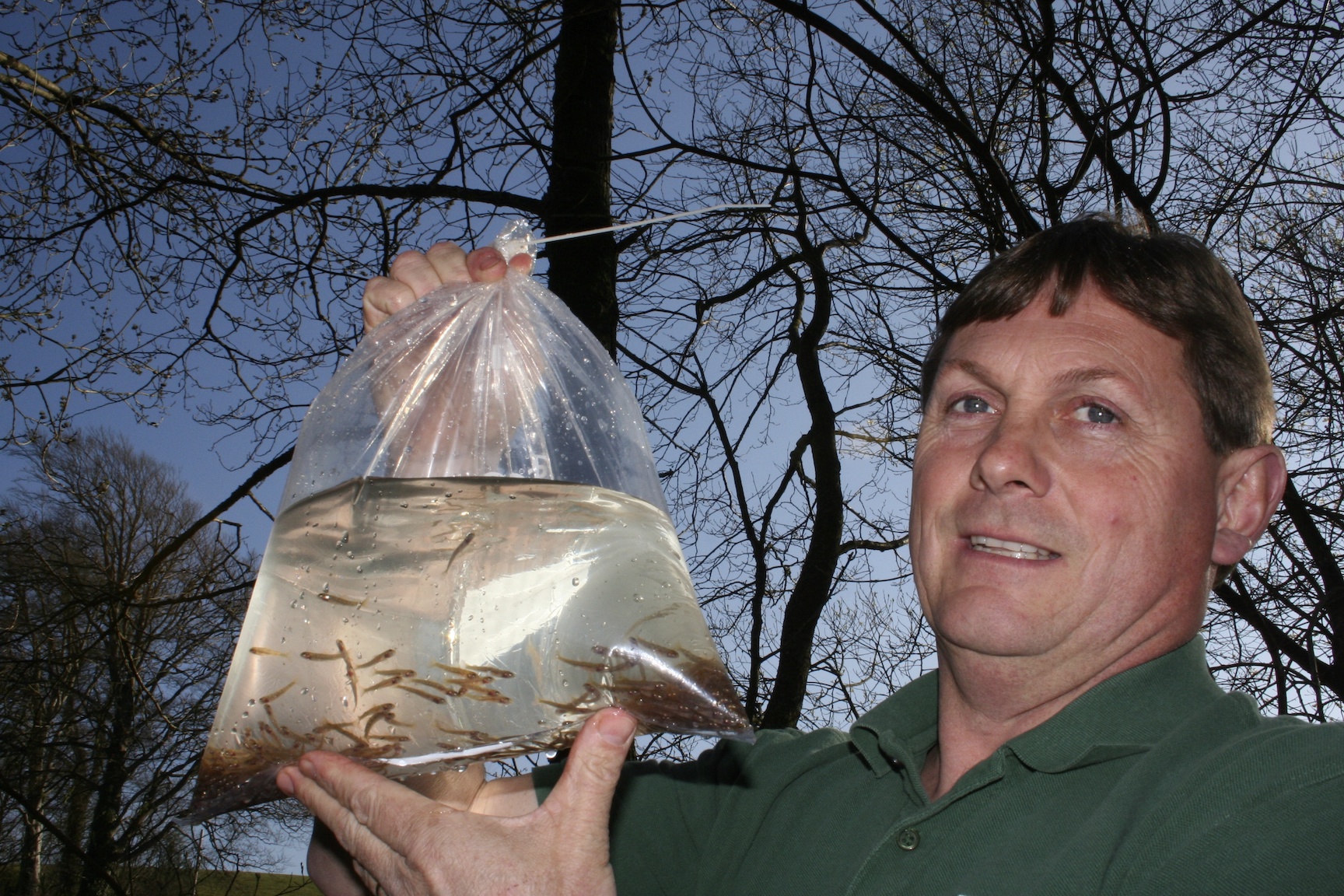
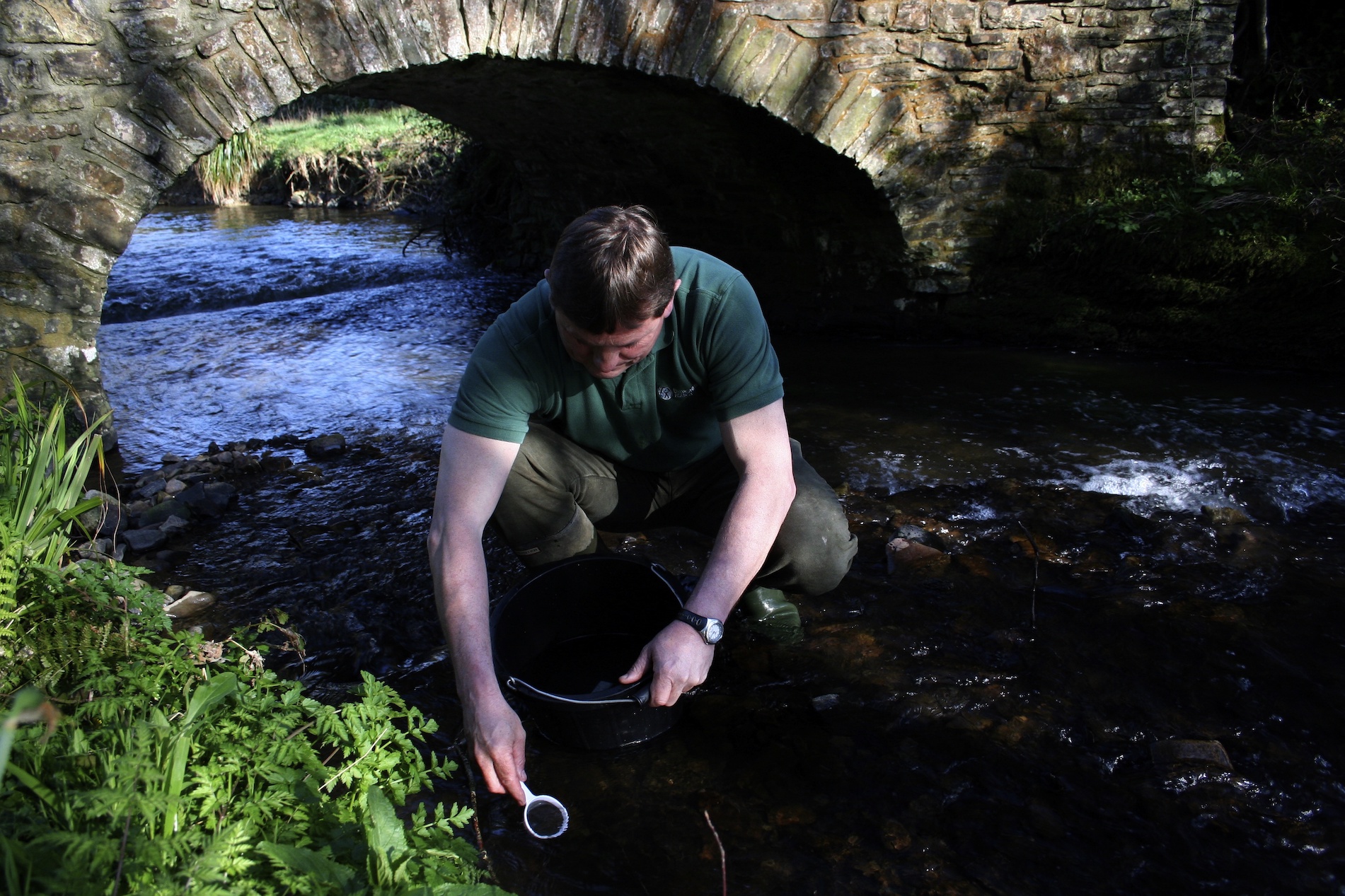
ANGLERS PASSIONATE ABOUT DEVON RIVERS – RTFCA AGM
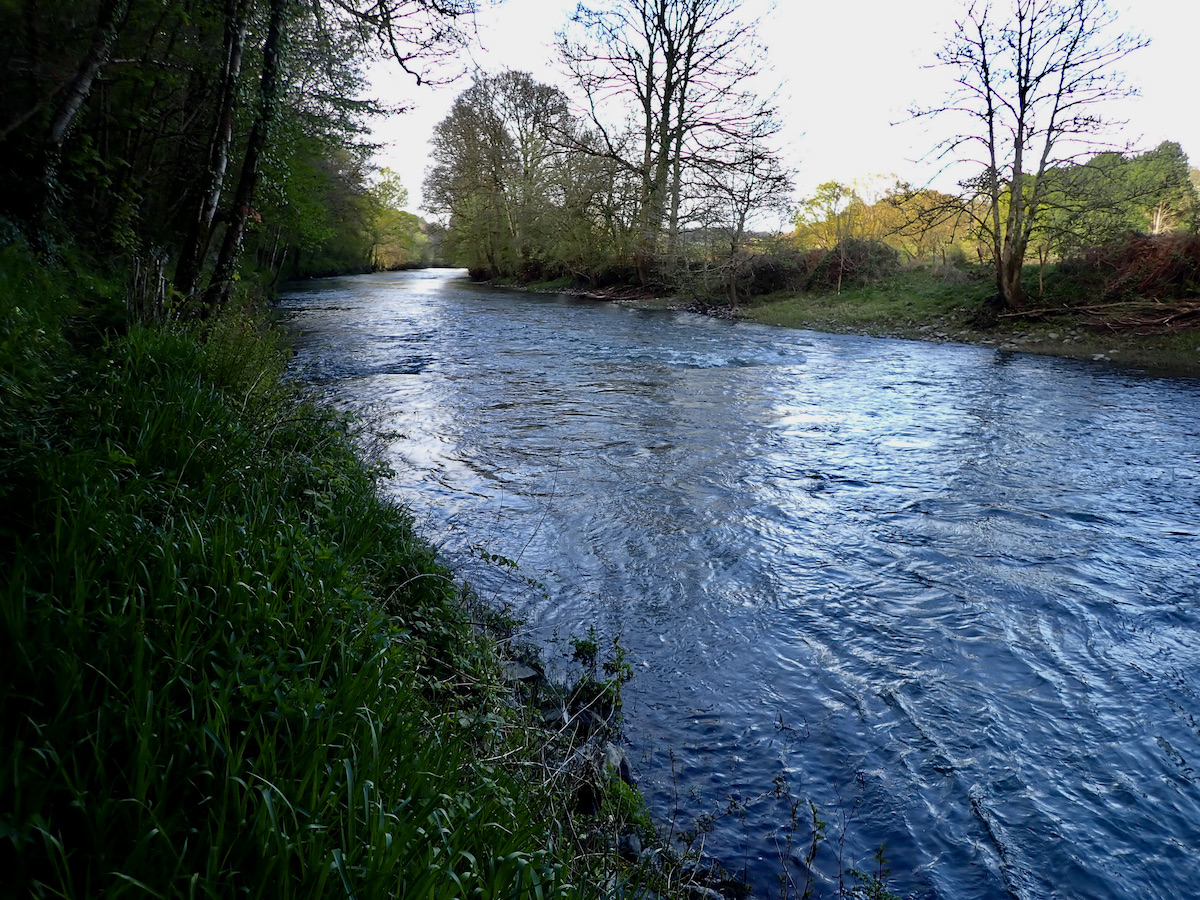
The River Taw Fisheries and Conservation Association held their AGM at The Fox and Hounds Country Hotel last Friday. Chairman Andy Grey reported on a disappointing season in 2024 with salmon catches the lowest since 1952. The Environment Agency statistics showed a consistent number of rod hours over recent seasons with an estimated 0.18 salmon per licence holder if my notes are correct. A month into a new season and no salmon have been recorded from the Taw. The Torridge has done rather better with three salmon recorded.
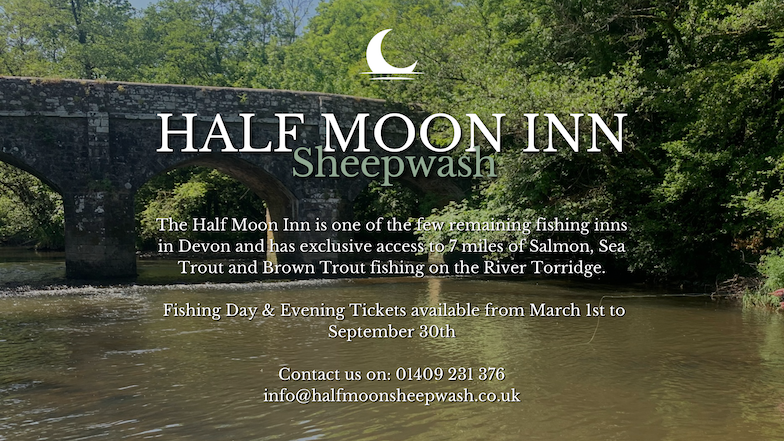 http://www.halfmoonsheepwash.co.uk
http://www.halfmoonsheepwash.co.uk
The environment was as always at the top of the agenda with the association working extremely hard with the North Devon Catchment Partnership to help raise funding for habitat improvement and enhanced water quality.
Members raised their concerns regarding water abstraction and pollution incidents with the EA officers. It was very apparent that the Environment Agency is understaffed with hard working ground staff covering a very wide geographical area. Agricultural practices and sewage overflows are undoubtedly the main concerns and progress is being made in combatting the issues via education and fines for breaches of consents. The Environment Agency officers present emphasised the importance of reporting any pollution concerns via the EA hotline number 0800 807060. Anglers are very much the eyes of the river and play a vital role in raising awareness.
The number of Environment Agency Fishery officers in Devon now stands at two a reduction from over twenty employed recalled one North Devon water bailiff present at the meeting. Whilst the issues facing rivers have changed to some extent over the decades and focus has moved more towards environmental protection it is obvious that political priority is not on the health of rivers. Observations of local sewage infrastructure indicated that there has been no significant upgrade in the capacity of some rural sites despite extensive housing development. South Molton being a good example of this.
The dedication of local environment officers including Sam Fenner and Harry Chance was noted with those present at the meeting eager to share their observations on the river and its many issues. There is a great deal of work being undertaken to work with farmers to ensure compliance and improved working practices to reduce soil run off and silage spills.
The association are working with scientists to gather vital data using EDNA technology to help build a picture of migratory fish locations including shad, salmon, sea trout, eels and lamprey. This will enable targeted investment over the coming years.
The Torridge Rivers Association held their AGM at the Half Moon Inn at Sheepwash the previous week where the environment was also high on the agenda. The main focus was the associations salmon hatchery that has successfully raised 33,000 swim up fry. These fry have now been stocked out into strategic areas of the Torridge river system.
The RTFCA welcomes new members and has launched a Facebook page and new website to help promote and engage. https://www.rtfca.co.uk
https://www.facebook.com/groups/RiverTawFisheriesAssociation
The first round of the Fluff Chuckers / SWLT Brown Trout Masters 2025
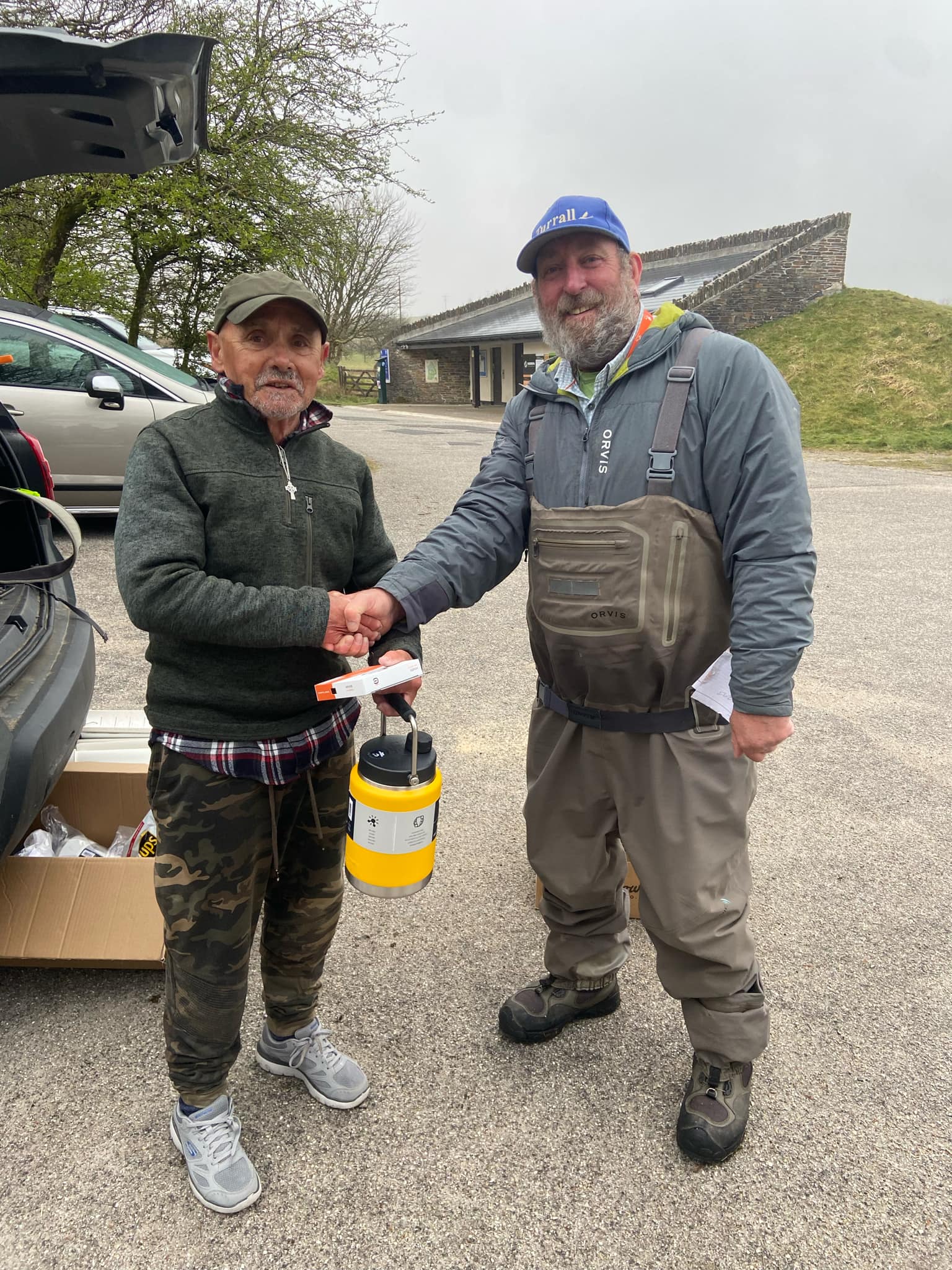
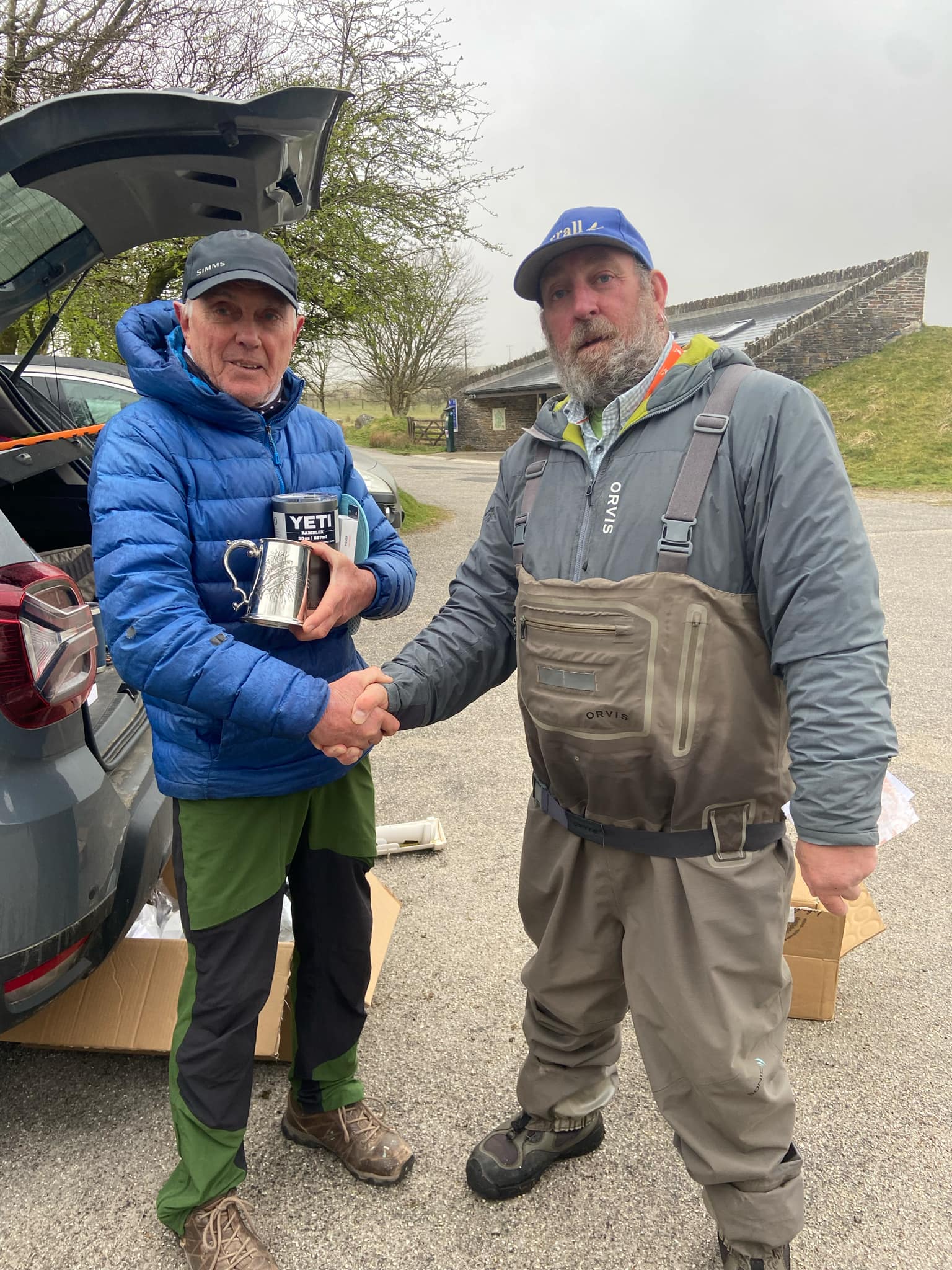
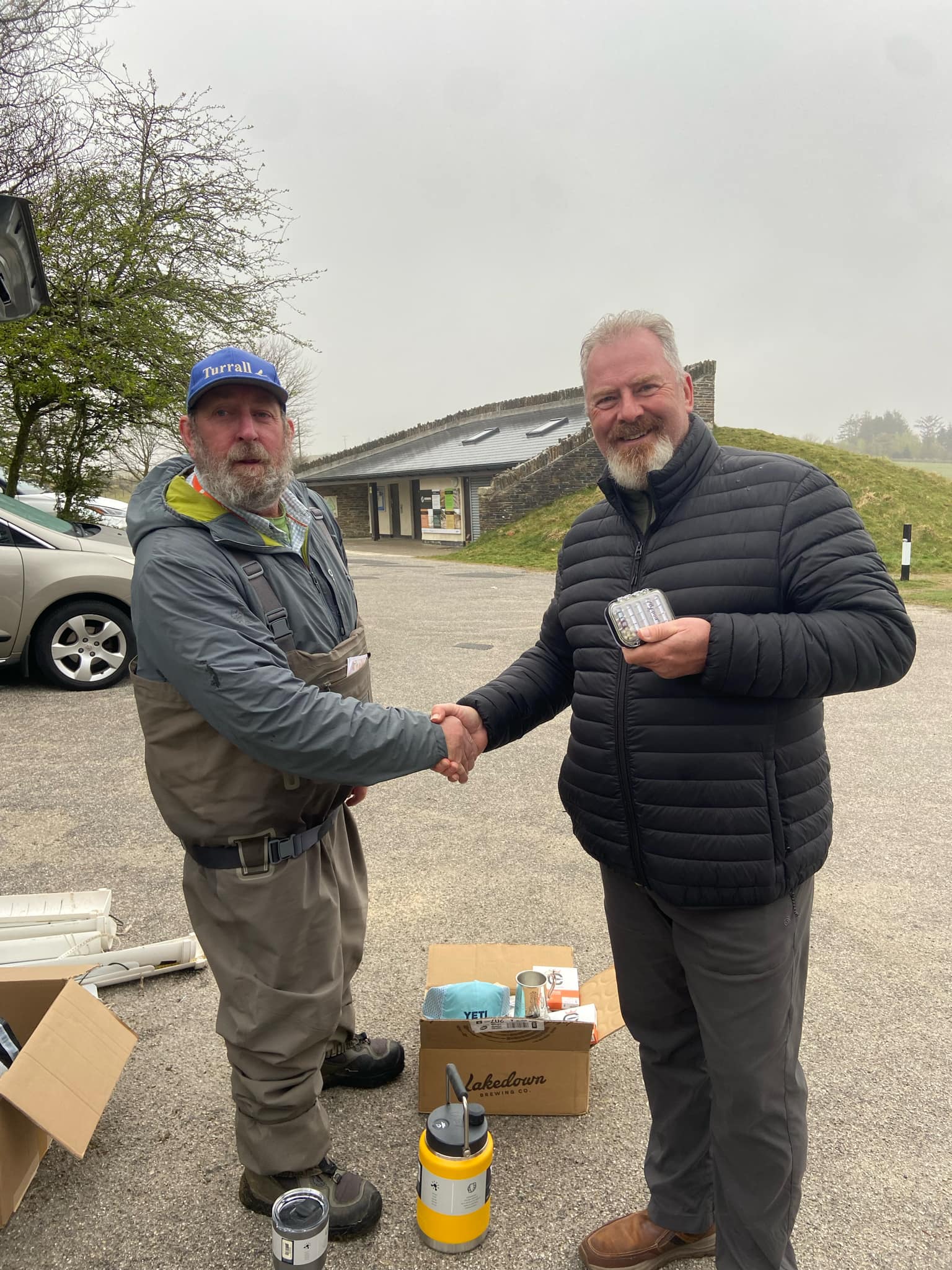
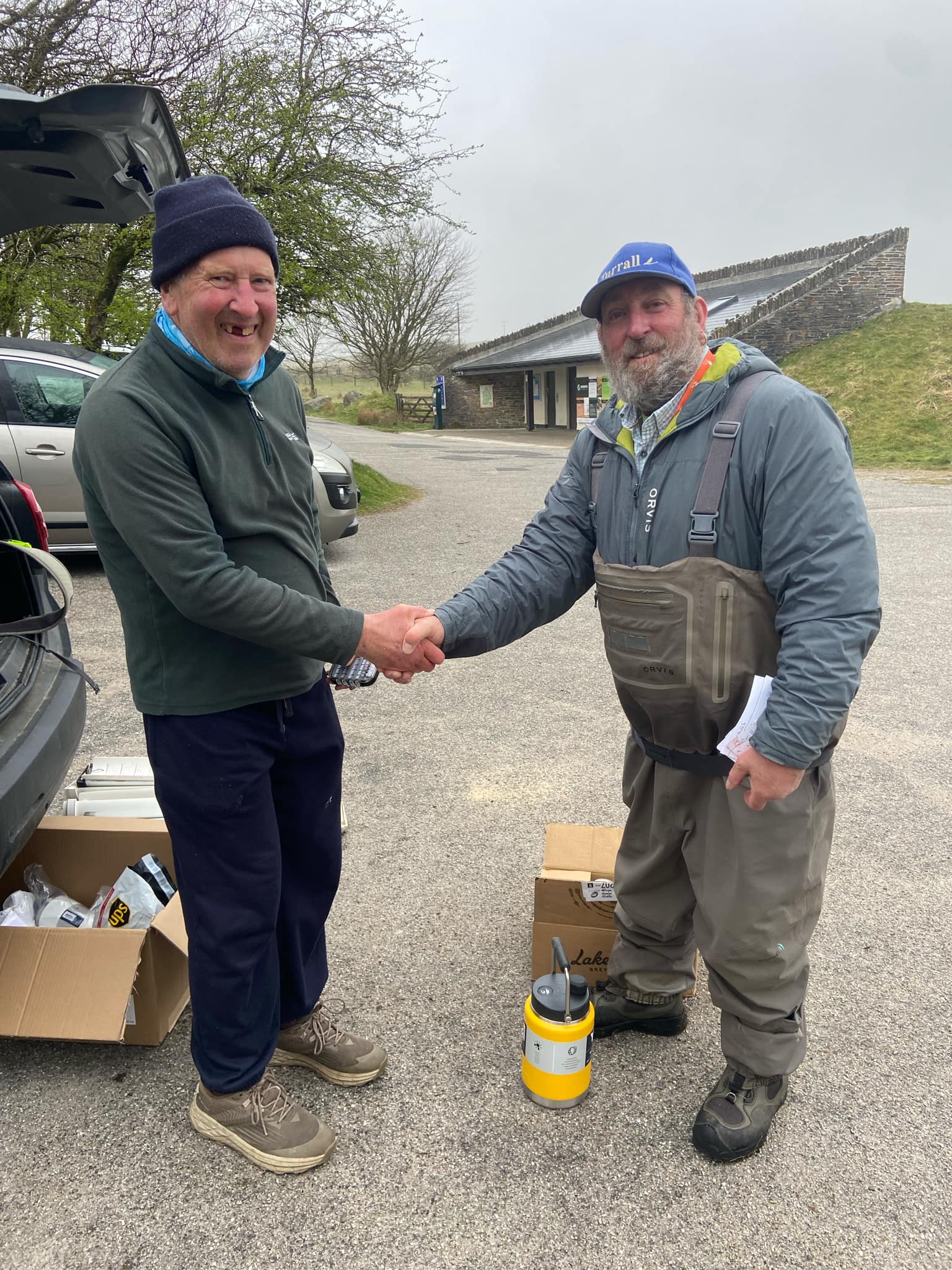
-
John Huckings 286 cm 2
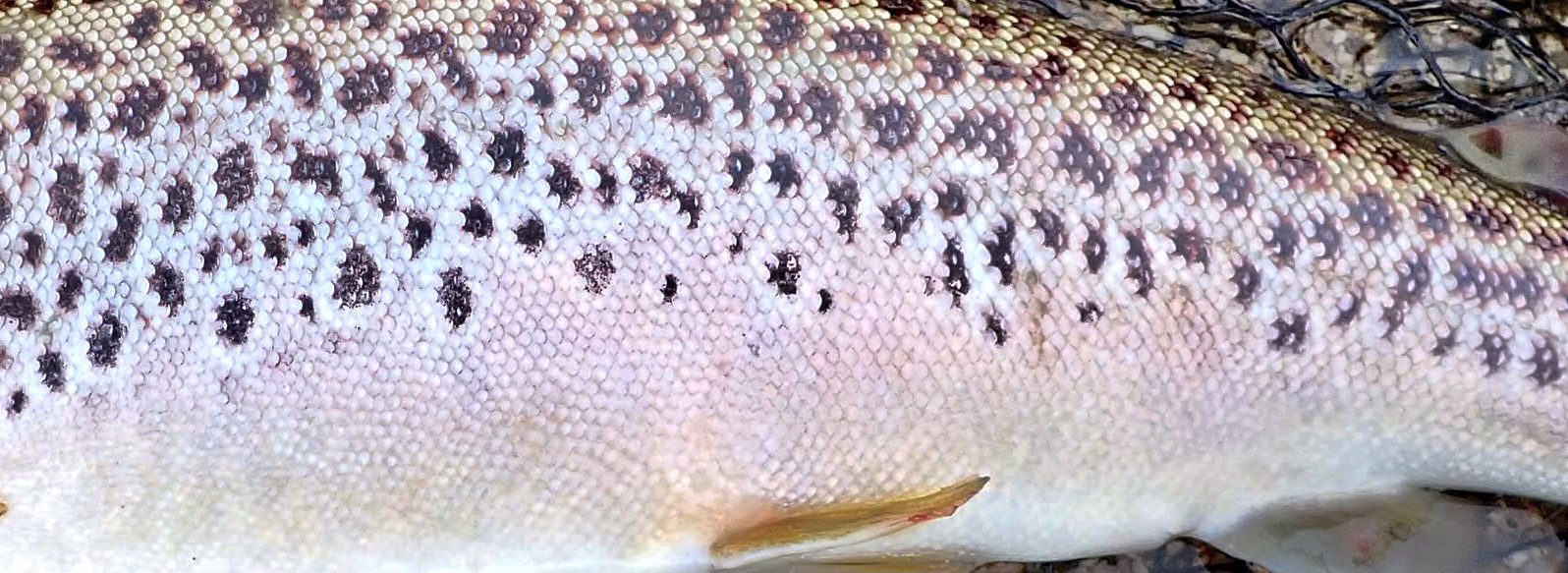
It hardly seems possible that another twelve months have passed since I joined the Fluff Chucker’s at Colliford high on Bodmin Moor. Fortunately I had learnt a valuable lesson that despite the favourable weather forecast it gets cold up there on the Cornish highlands. It seemed relatively mild and with a light breeze I pondered for moment before donning a thick fleece under my fly fishing vest and waders. Familiar faces were gathered around Rodney Wevills car as we collected our measuring gutters and received our goodie pack from sponsors Turral Flies.
We all headed eagerly to the water’s edge with competitors heading to their favoured areas. I had a cunning plan to head to where I had fished before and with a gentle breeze blowing into the bay I felt sure a few fish would be present close in. I had set up with my new Snowbee Floating Line and leader with three flies. A black bead headed tadpole on the point, Black spider on the middle dropper and a black and red Zulu on the top dropper a combination that I would have confidence to fish most days in early spring.

The first hour proved difficult as I searched the water contacting a decent trout after ten minutes that threw the hook after a few seconds and a spectacular somersault!
A short while later the line again tightened and for a second or two I thought I had hooked the bottom; that slowly started to move followed by a glimpse of a thick spotted flank that erupted from the water in a flurry of spray! This was a beauty I thought but elation turned to despair as the hook hold gave way the big brown trout disappearing from whence it had come. Another tale of the one that got away added to life’s toll!
The leader was left tangled requiring a re-tying. This was not a brilliant start, then the wind started to strengthen and I nearly lost my cap the fastening button failed. I pulled my buff up over my cap and soldiered on as the wind picked up. I persisted for a while but no more takes followed and a move seemed a good idea. I walked a half a mile or so to an area I had caught from on my last two visits.
First cast and I hooked a trout that came detached after a brief leap from the lake. Fifty yards further along the bank and I hooked a brown trout of 36cm. Two casts later a beauty of 42.5 cm was safely in the net. Things were starting to come right and I fished on now with renewed confidence.
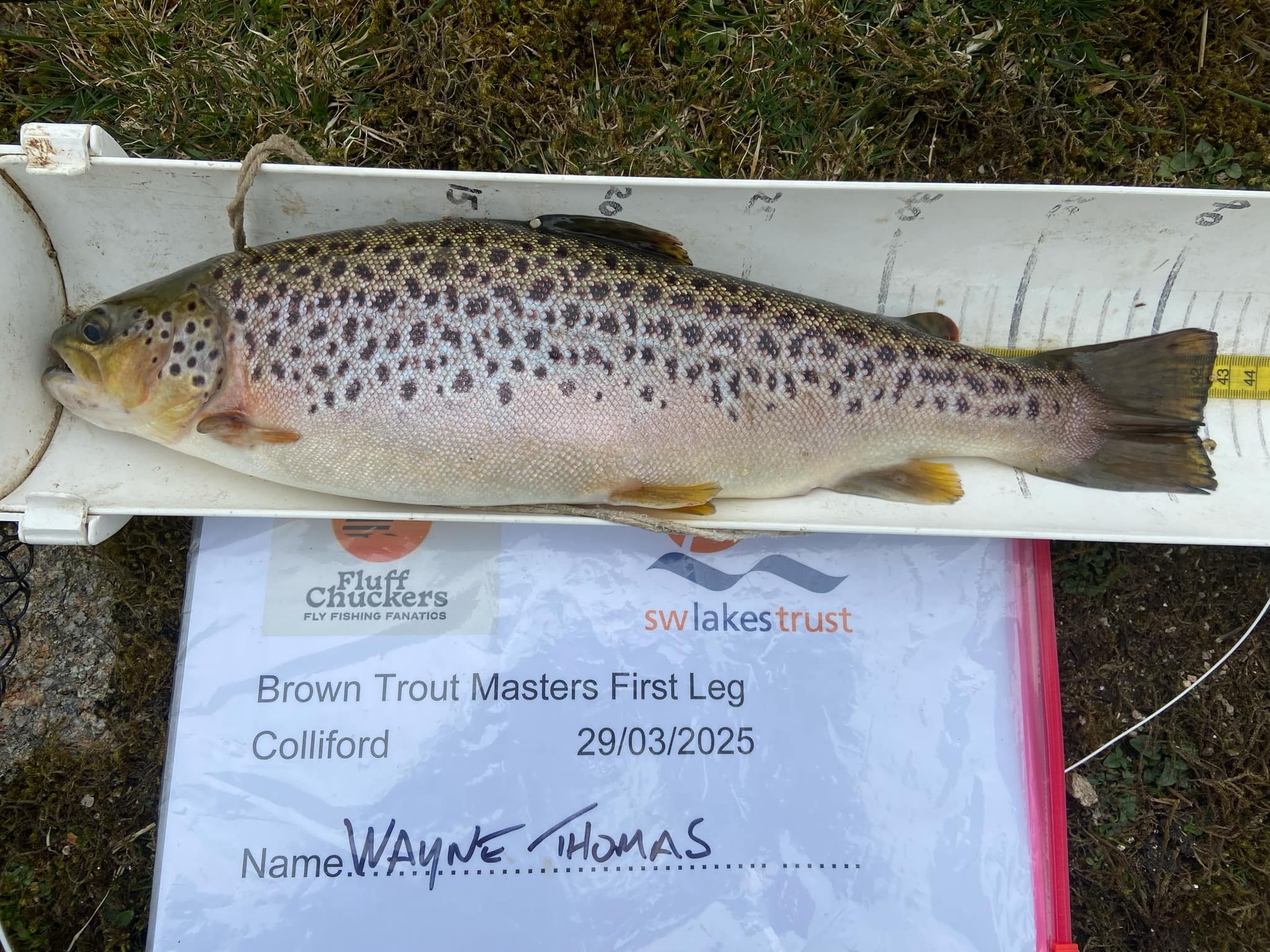
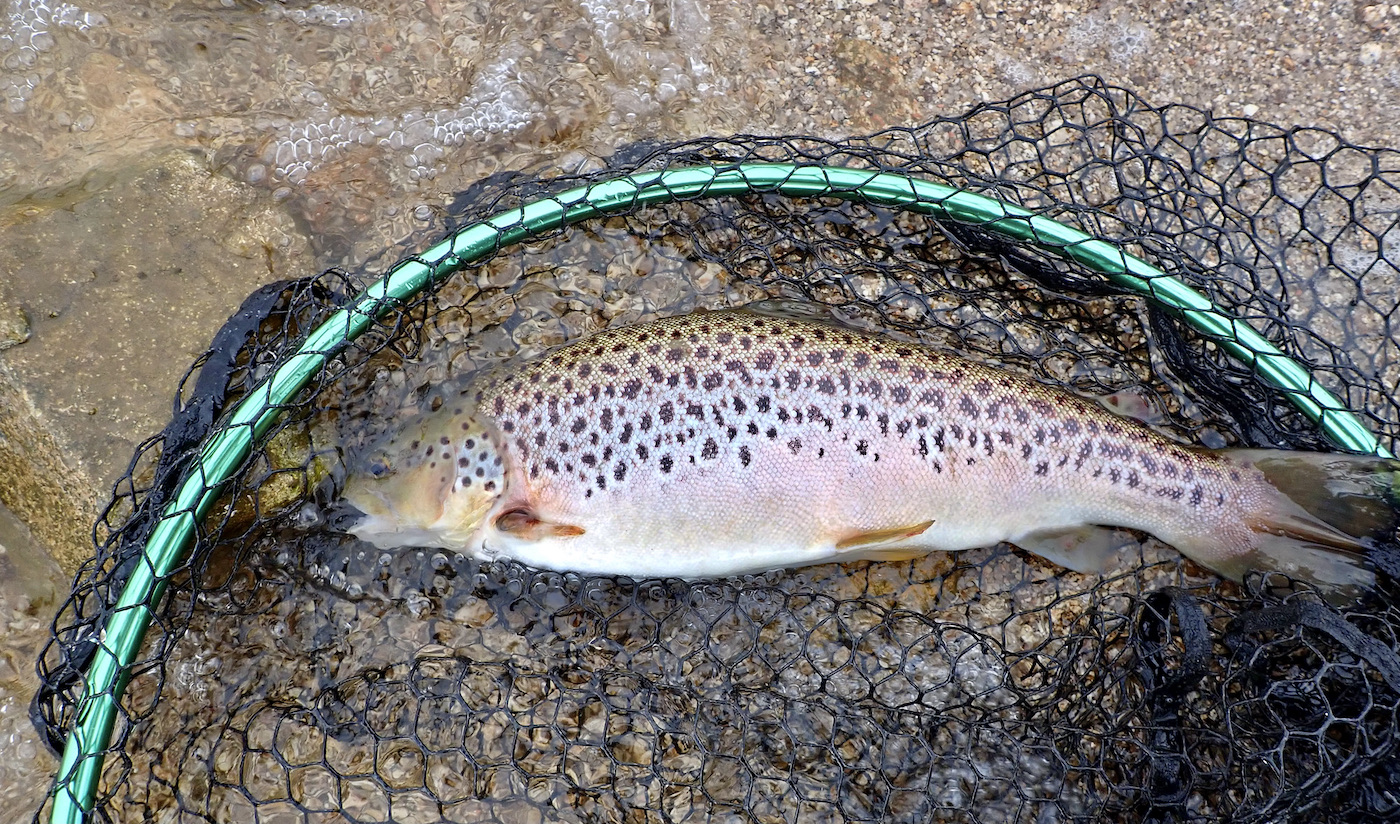
The wind was by now strong and bitter cold with the sun hiding behind grey clouds making it a rather bleak and inhospitable environment.
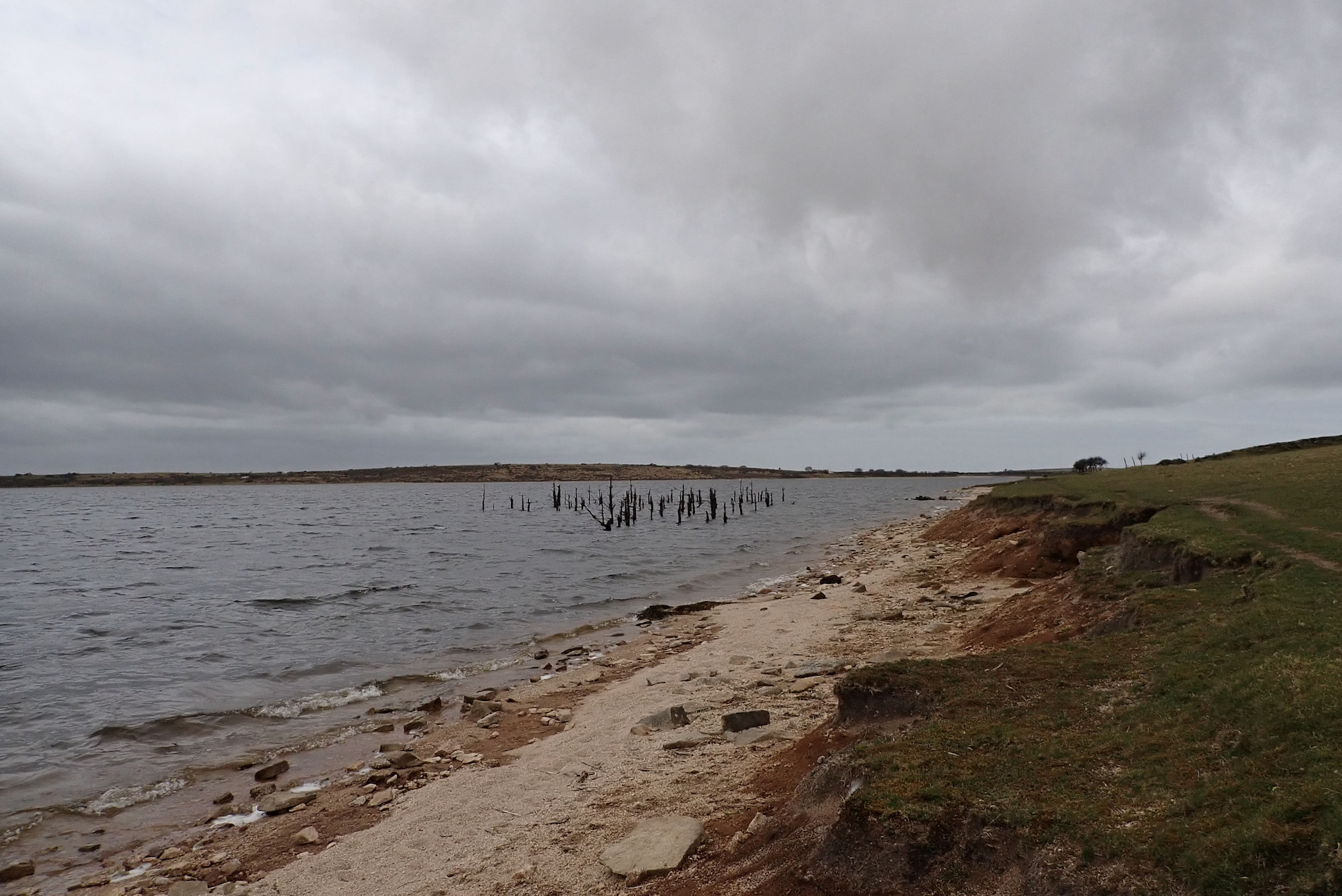
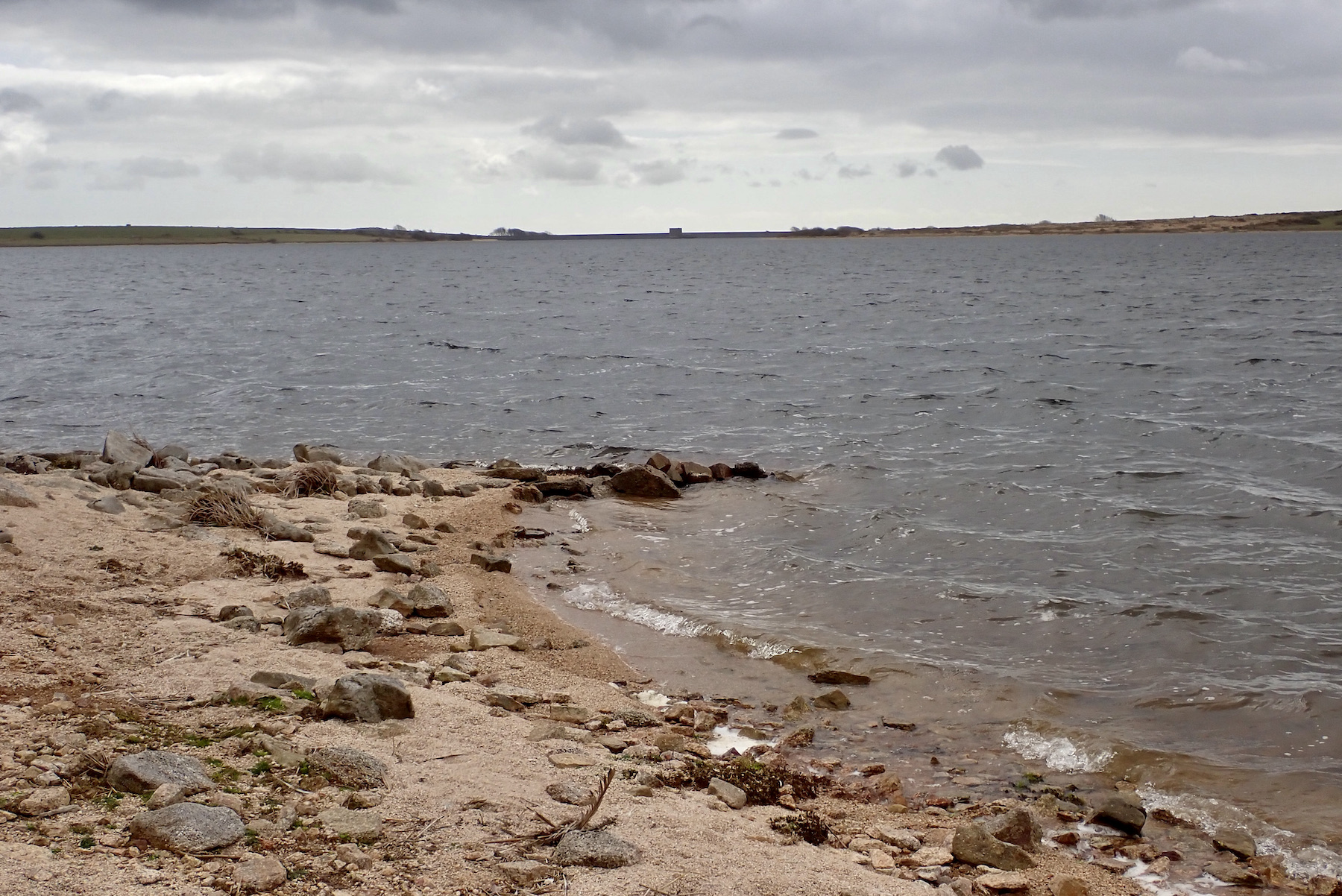
I added another small brown before deciding to head back to where I had started the day adding another two trout to end the day with five trout. In truth I wasn’t to disappointed to reel in at 5.00pm and leave the cold water behind for a while.
Back at the end of competition meet up Rodney worked out the results and I listened as tales of the day were told. The cold wind had resulted in widespread chilling to the bone, slip and trips, bloodied fingers from stray hooks and plenty of tales of escaping trout. All agreed through chattering teeth that it had been a great day and that the next event is eagerly awaited.
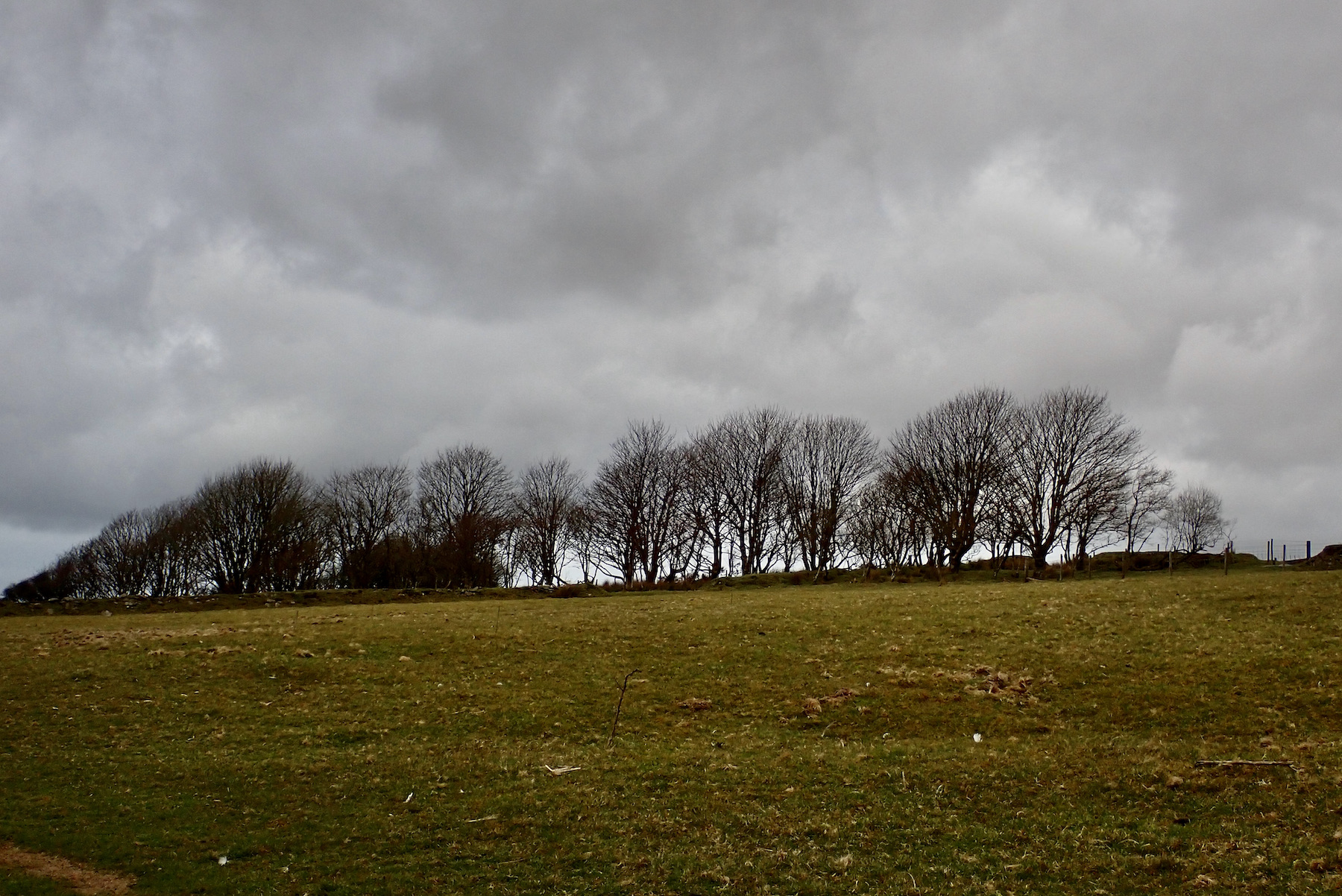
PREDATOR 2 – Website and diary launch !
Exciting opportunities to experience boat fishing off the North Devon Coast and beyond with new Ilfracombe based Charter boat Predator 2.
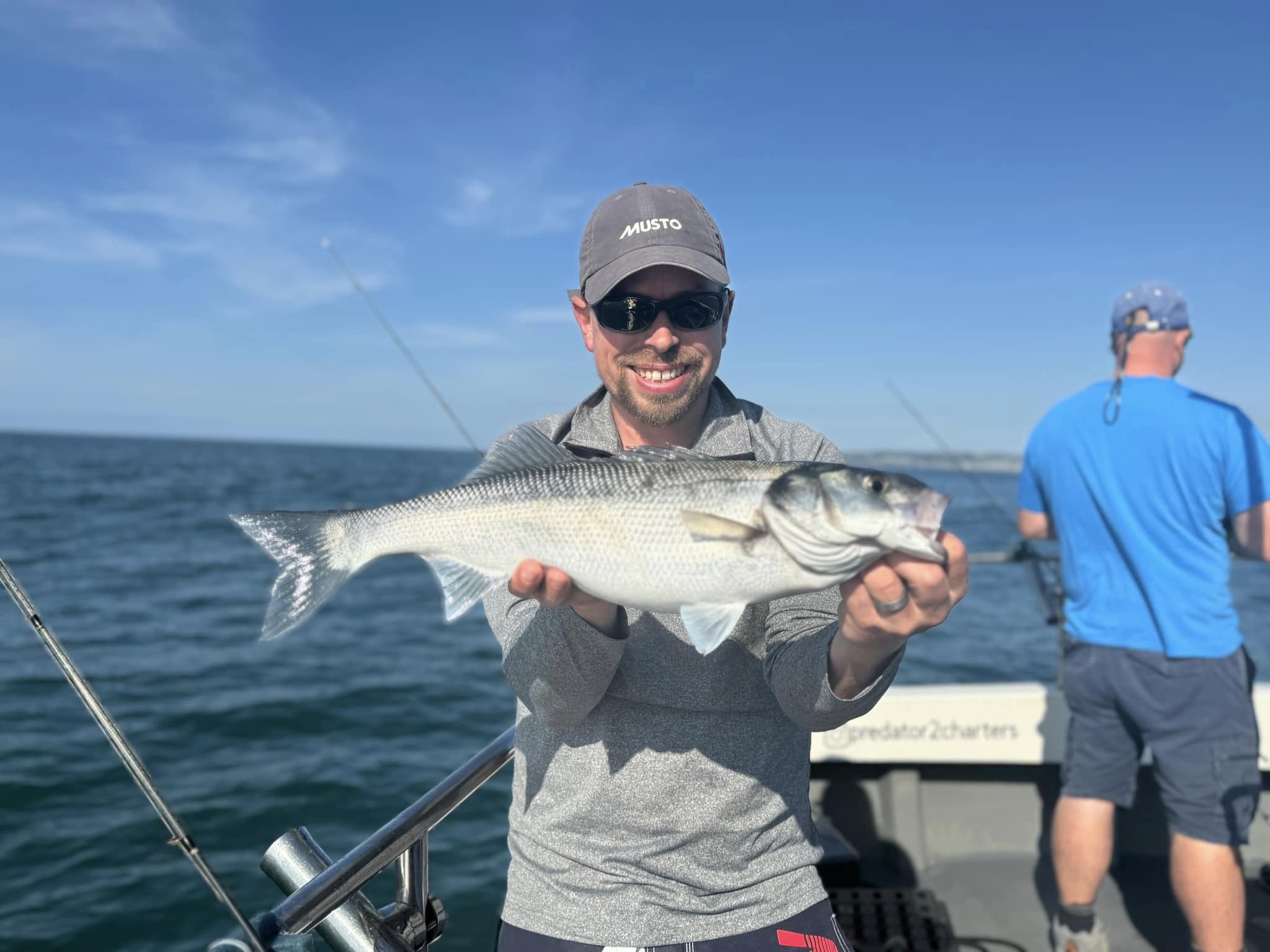
THE TEIGN BOOK – A REVIEW
THE TEIGN BOOK
THE STORY OF THE RIVER TEIGN RESTORATION PROJECT AND OTHER ASPECTS OF THE CATCHMENT
NEIL YEANDLE with photographs by Mike Rego
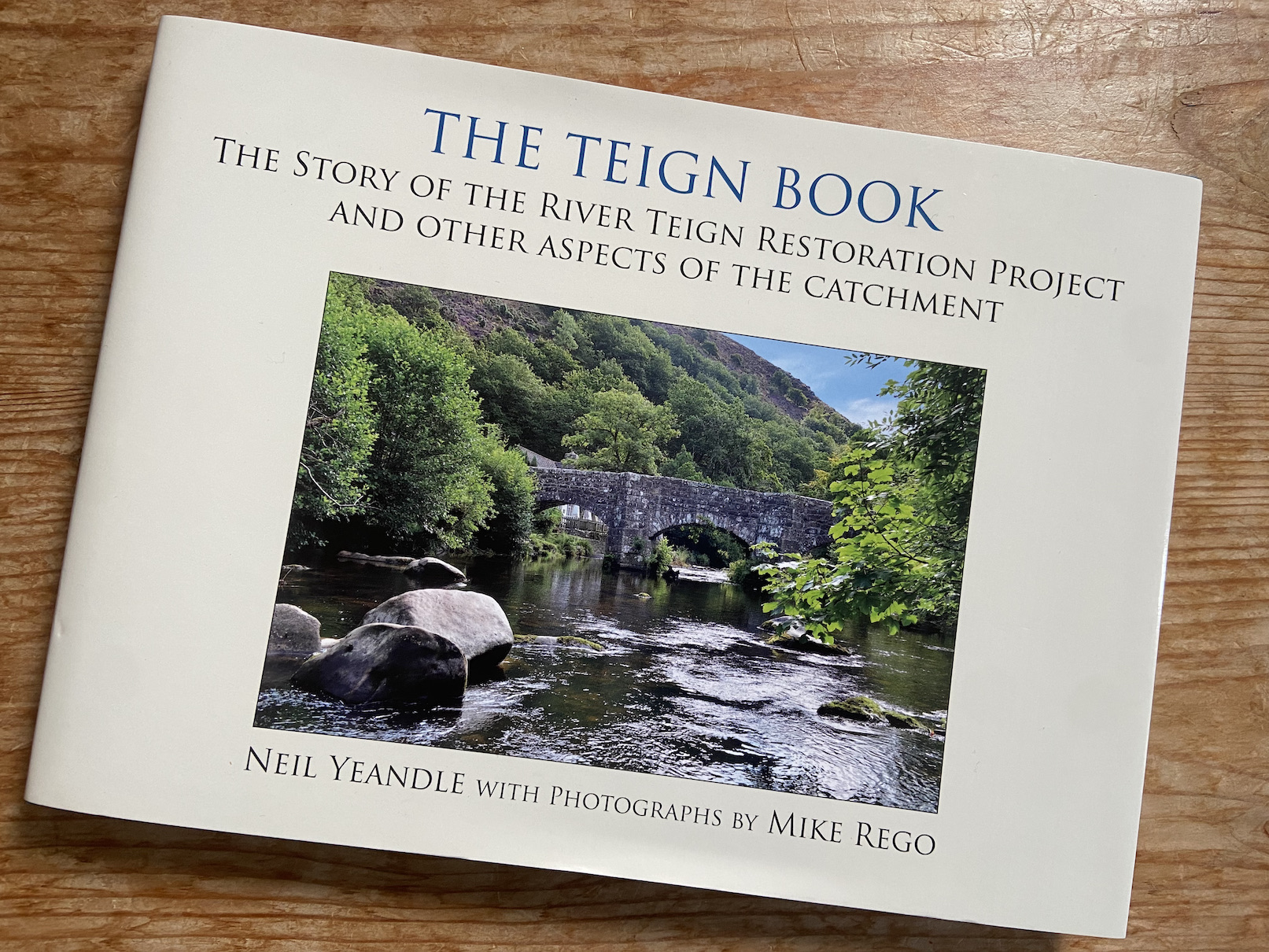
Rivers inspire with their unique histories as they flow through our green and pleasant lands and it is anglers who are amongst those with the deepest connection and passion. This is evident throughout the pages of the Teign book written by Neil Yeandle who has produced a very comprehensive and informative book on this fascinating and beguiling river.
Neil is a lifelong angler whose connection with the Teign commenced when he moved to the West Country in 1988. He became a member of the Lower Teign Fishing Association in 2001.
‘As a keen sea trout angler, he soon fell in love with the Teign, although night time angling and work were never a great combination. After setting up a business Partnership, and later his own company in 1988, he was fortunate enough to be able to retire in 2011, leaving him more time to pursue his passion for angling. Neil has served on the Lower Teign Fishing Association for many years and as secretary of the Teign Angling and Conservation Association since 2013. He volunteered to write a book as part of the River Teign restoration Project and this is the fruits of his labour.’
Passion and dedication to the river Teign the environment and of course its fish are apparent throughout the pages of this book. I was encouraged to write a review of this book by Roger Furniss, Chairman of The Teign Angling and Conservation Association. I feel honoured to have been given this opportunity and as an avid collector of fishing books it was a task I relished.
The Teign book is far more than a fishing book for it delights and informs readers with an evocative story of the river and its tributaries. The full life and extraordinary cycle of salmon and sea trout is explained in detail and enhanced with the colourful illustrations of Robin Ade . The fascinating natural history and man-kinds impact over the centuries is fully documented as the Teign plunges from the rugged heights of Dartmoor to the estuary at Teignmouth.
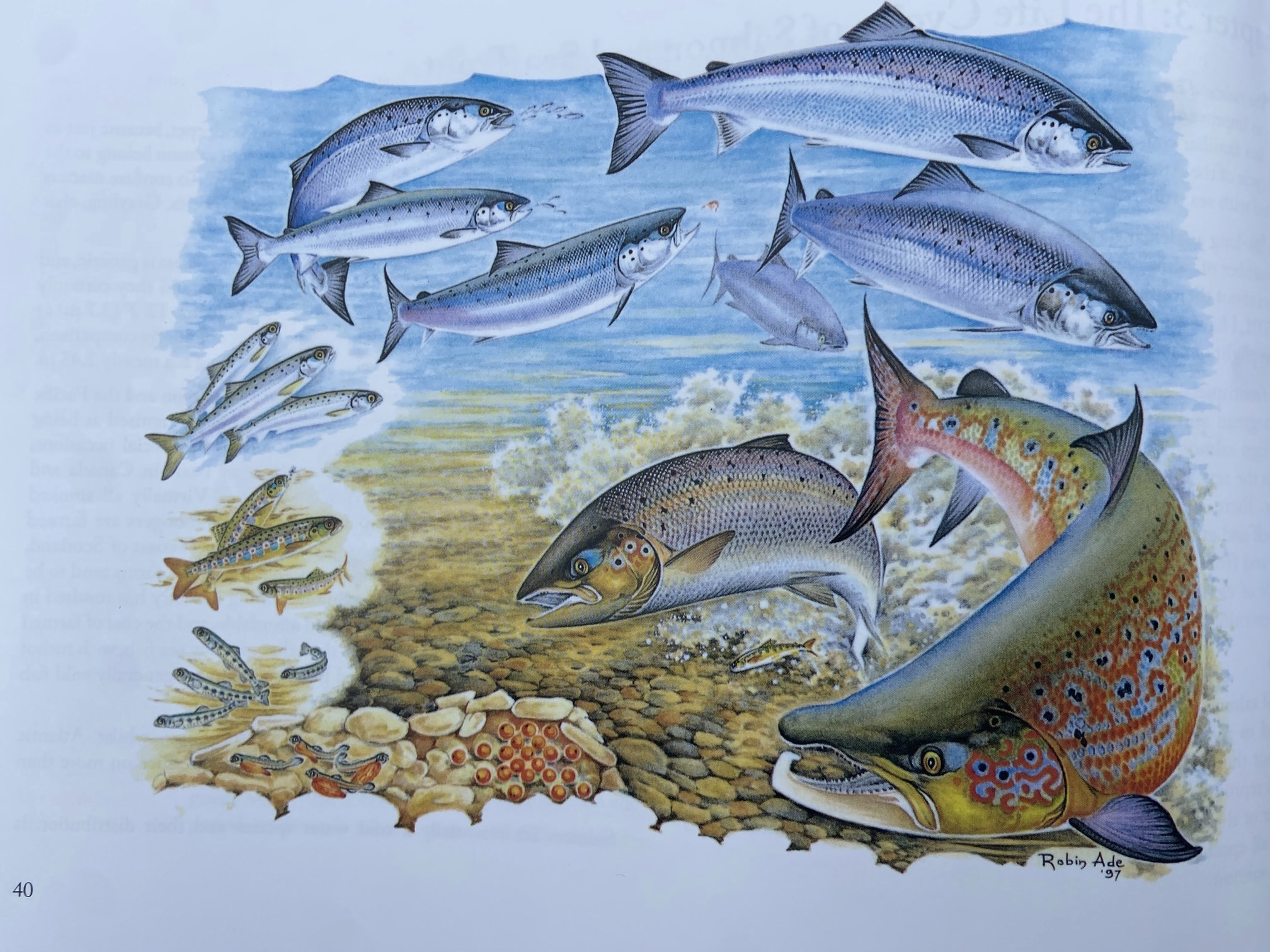
The book contains a wealth of photographs taken by Mike Rego and many others donated by many interested parties. These images are a valuable addition to a rich and informative text.
I have yet to fish the River Teign though I have developed a close interest in the river after reading of its fish in several books and articles over the years. My wife and I have also walked the banks of the Upper Teign as it flows through the deep wooded gorge below Castle Drogo and stayed close to the river during a short break at Chagford during the summer of 2024. I glimpsed good sized trout lurking in the sunlit waters that had that beer stained colour that always adds a sense of depth and mystery.
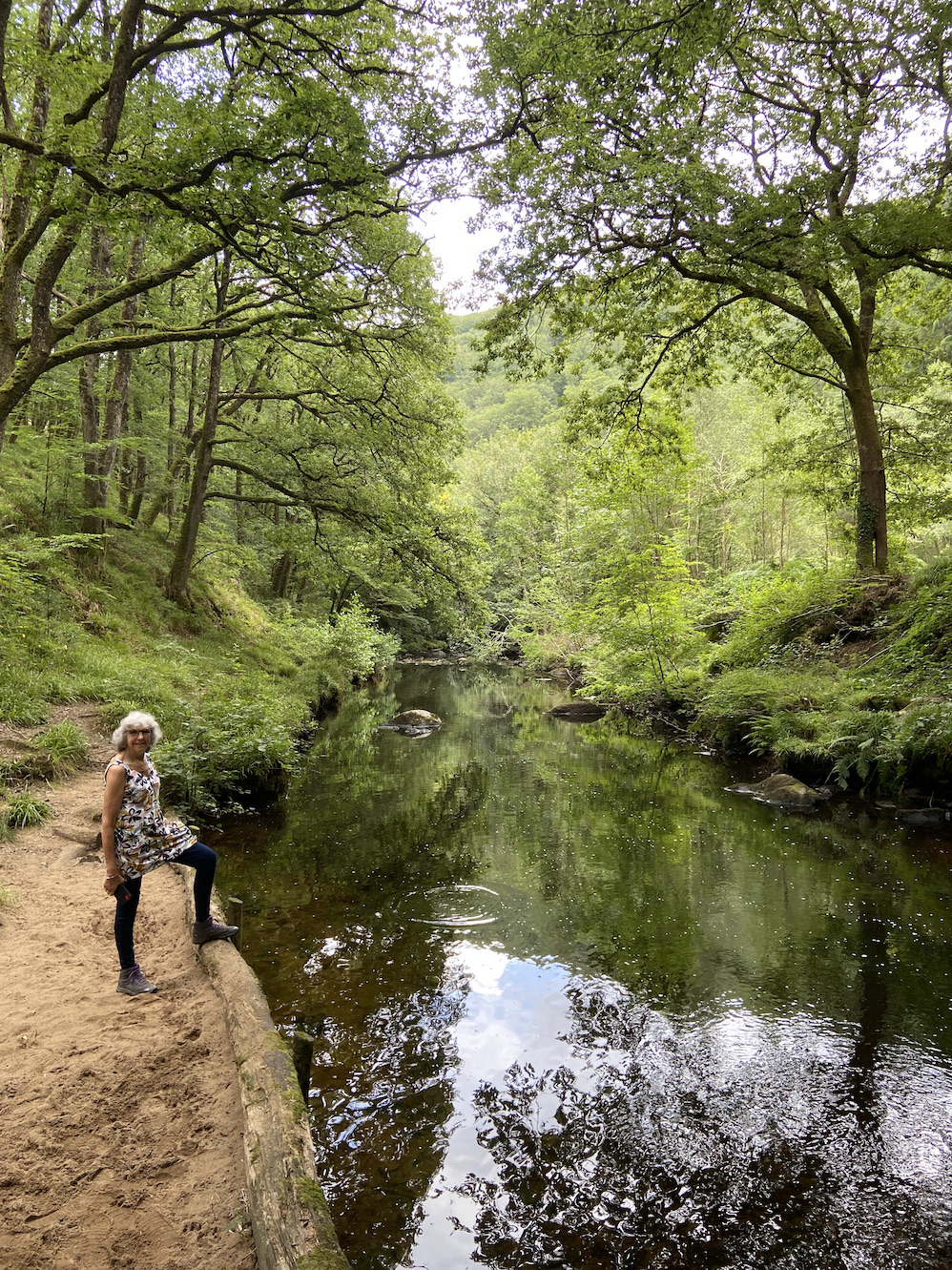
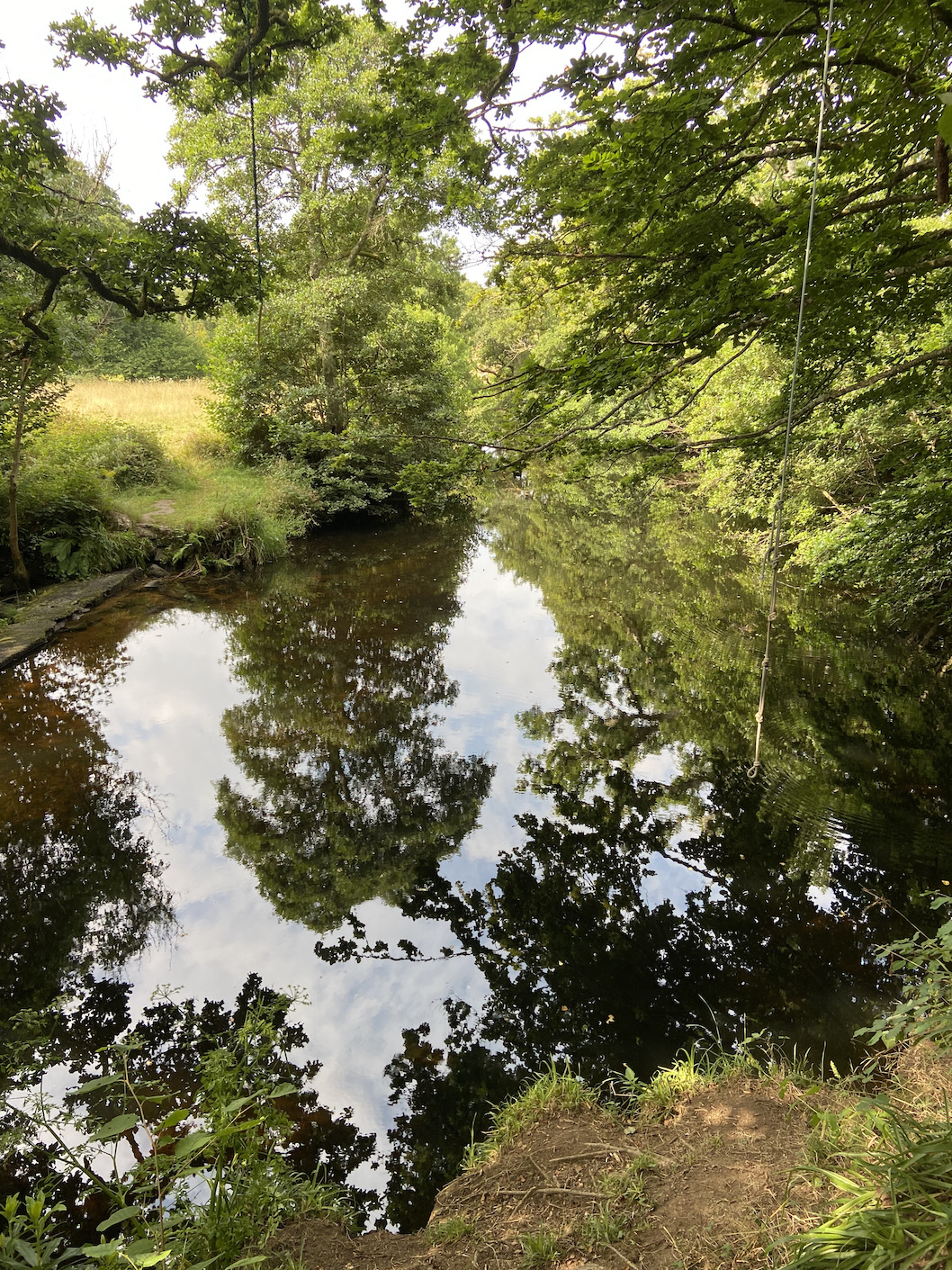
I also enjoyed some success whilst fishing at Fernworthy Reservoir at the head of the South Teign.
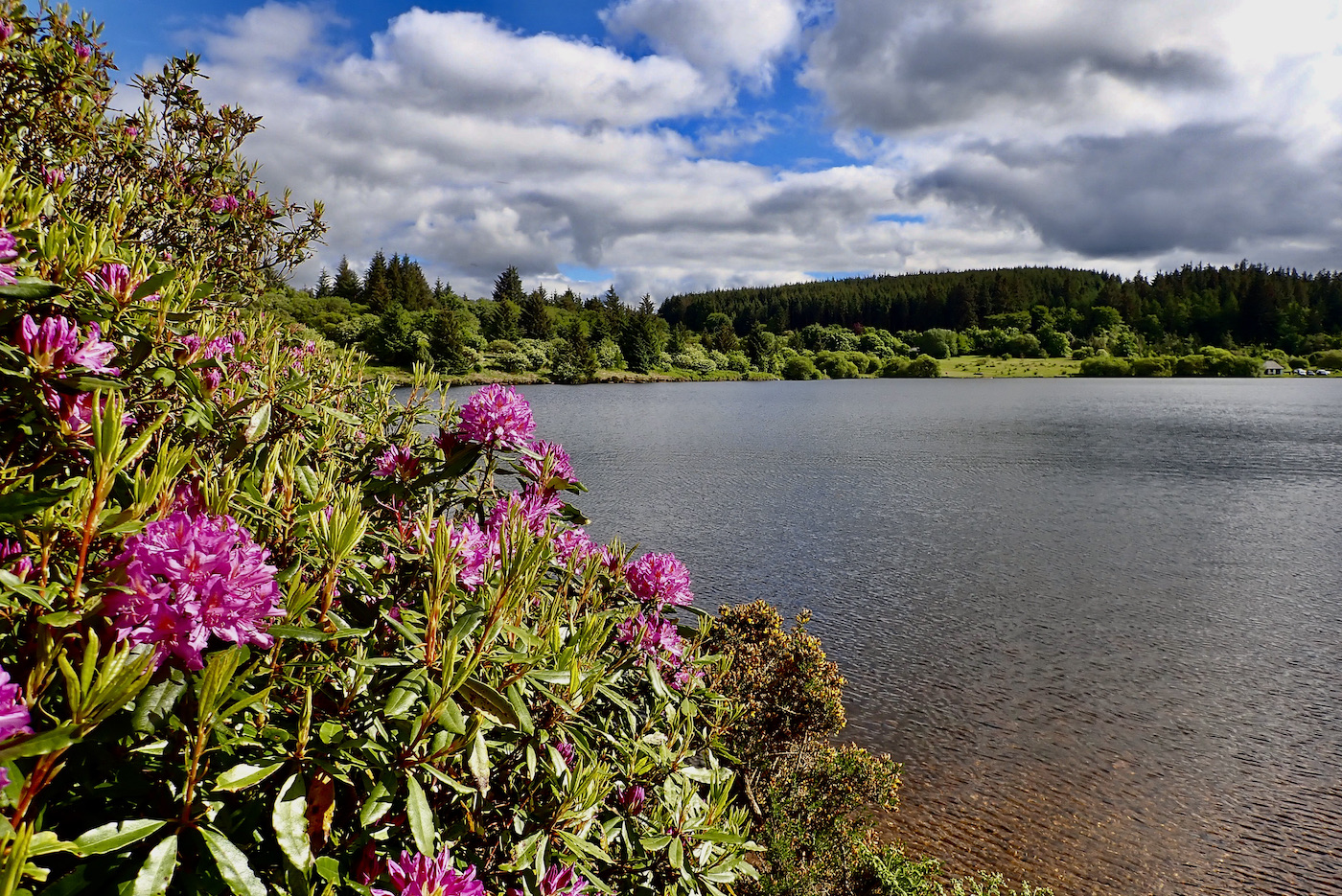
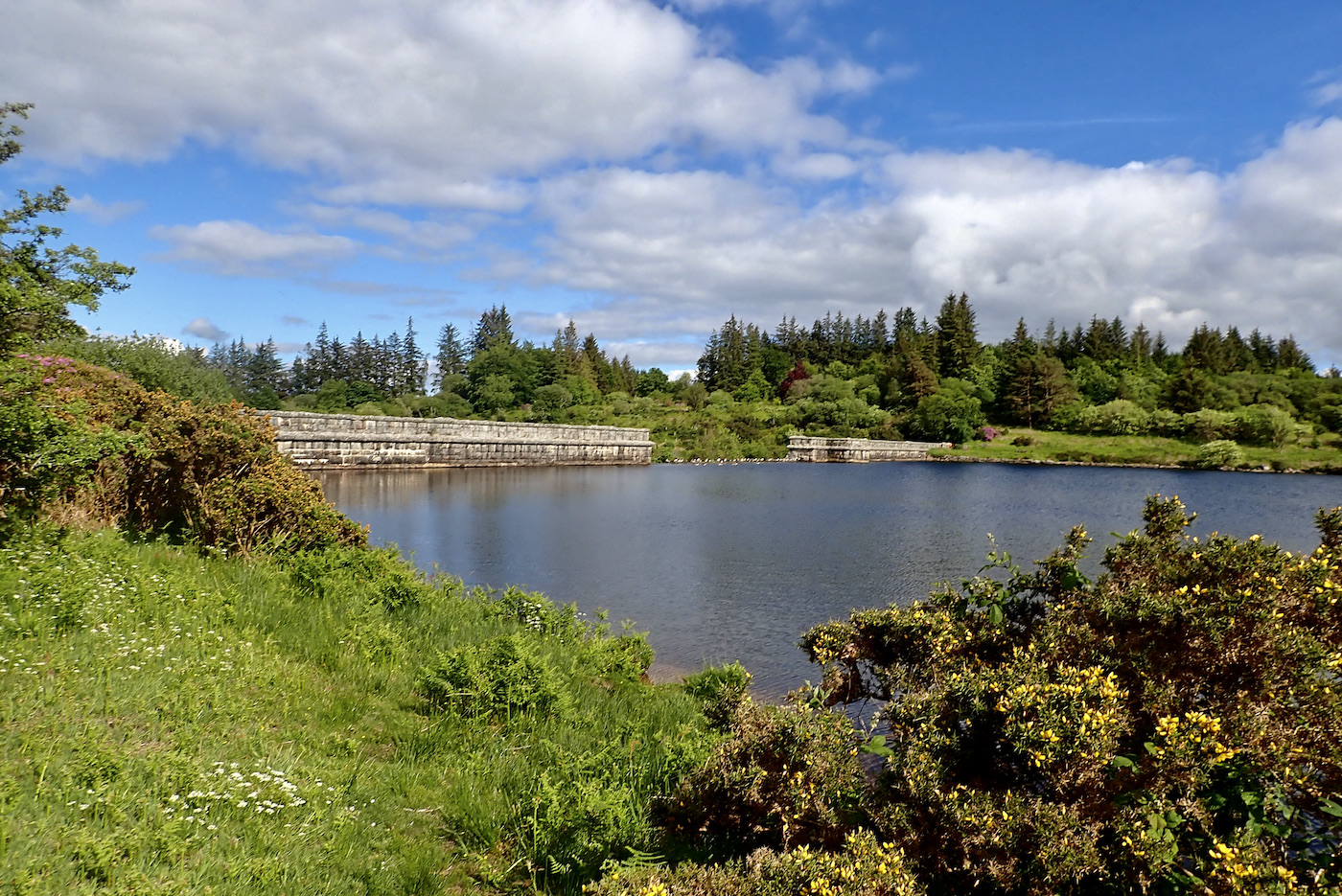
I have long held the belief that each river has a distinct and unique character undoubtedly influenced by its history and geological location. This belief was fully endorsed as I devoured the contents of this comprehensive account of the Teign. The stories and accounts of angling trips entwined with folklore and superstition add an entertaining and intriguing dimension to the book.
The fact that a rivers life spans millions of years is told within the pages and it becomes increasingly apparent how mankind’s hand has impacted in recent history. The key purpose of the Teign Restoration project is to raise awareness and engagement with the public in regard to the catastrophic decline of salmon and sea trout.
The sad story of salmon decline in the book is one that is replicated across the West Country and the Teign’s anglers have certainly shown determination to do all that they can to try and reverse this decline. The gathering of vital data over several years via walkover surveys, redd surveys, electro fishing surveys, river fly surveys, tagging projects, piscivorous bird surveys, in river works and temperature logging has provided an in depth knowledge of the rivers vital habitats and interconnected eco system. This data is used to channel effort into habitat improvement ensuring that work is invested wisely.
In addition to all of this work a salmon play, Our River Poetry competition and an exhibition at Castle Drogo have helped to engage with an audience far beyond the angling community.
https://www.medtheatre.co.uk/projects/river-teign-restoration-project/
The book is a celebration of hope for the future and how anglers and conservation bodies can work together. The Teign is a beautiful river its journey from source to sea through a vibrant landscape deserves to be told and this book gives a fascinating insight into a river as a living part of the land in which we live. After reading the book I am inspired to explore the rivers valley and maybe even search for those stunning fish that haunt its mysterious shaded pools.
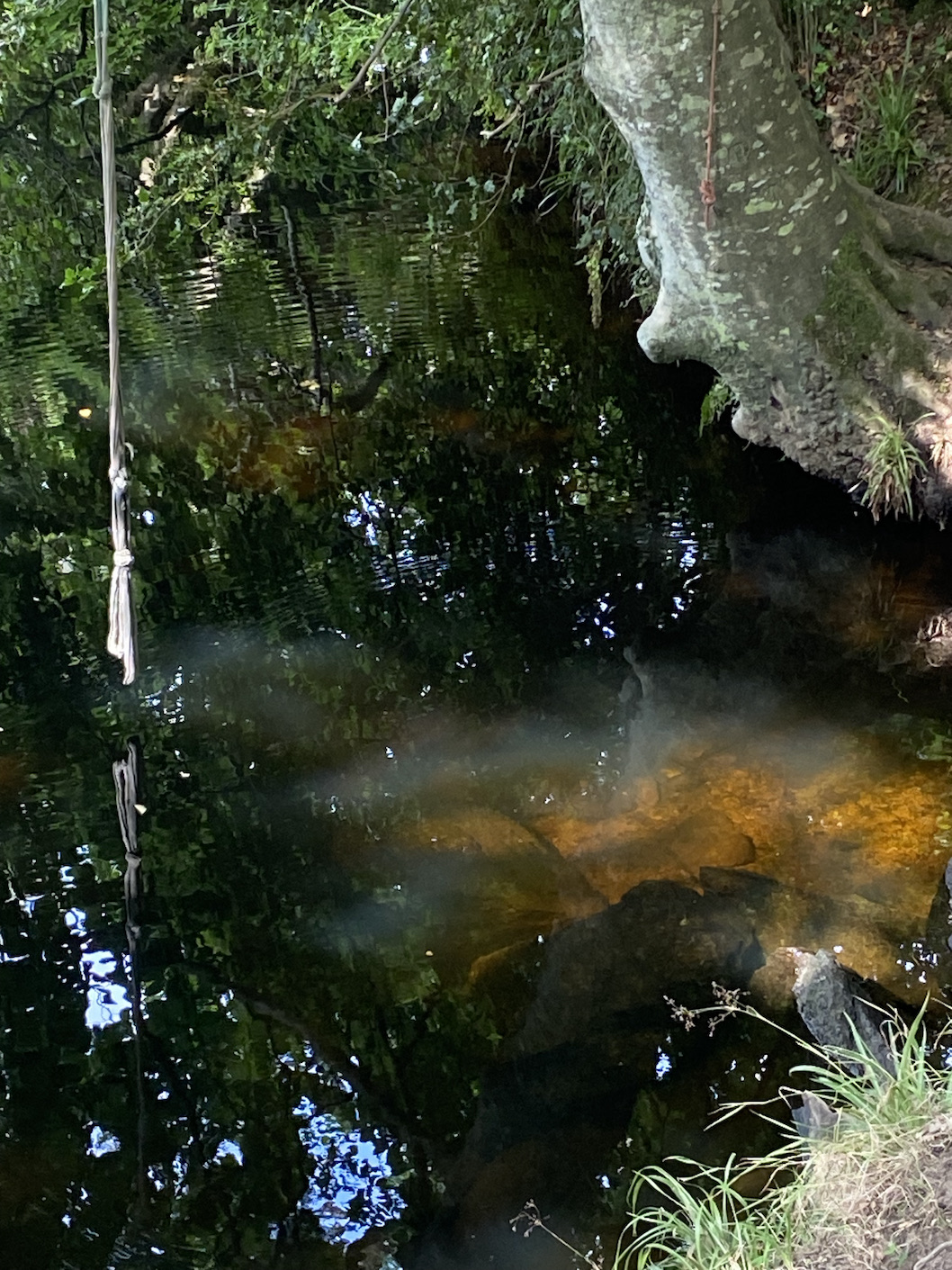
Predator 2 – Charter Boat Ilfracombe – Opens Diary in Exciting New Venture

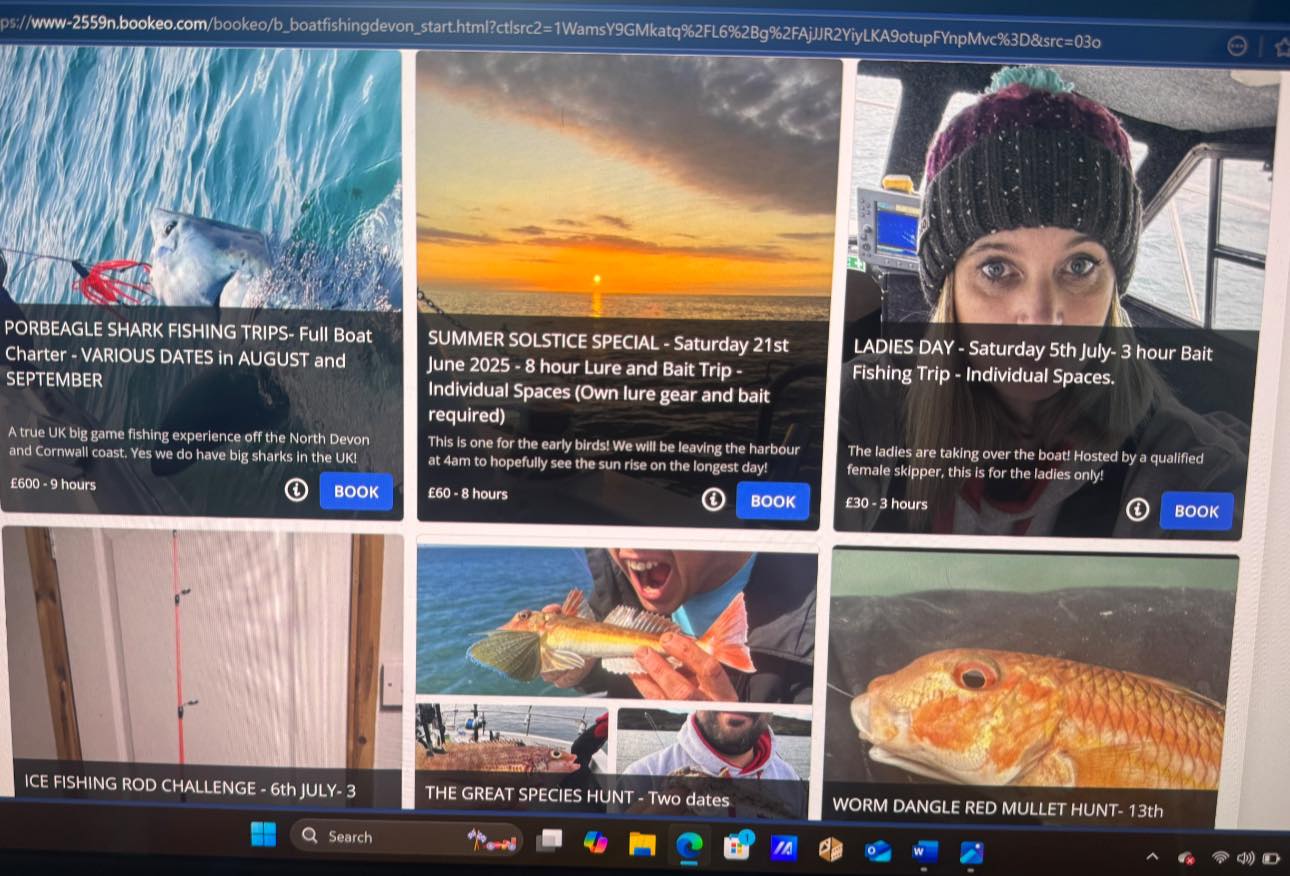
Our 2025 diary has something for everyone. We’ve got a few different sections in the booking site including some specials.
Full Report from Bulldog Fishery
Full Report from Bulldog Fishery
